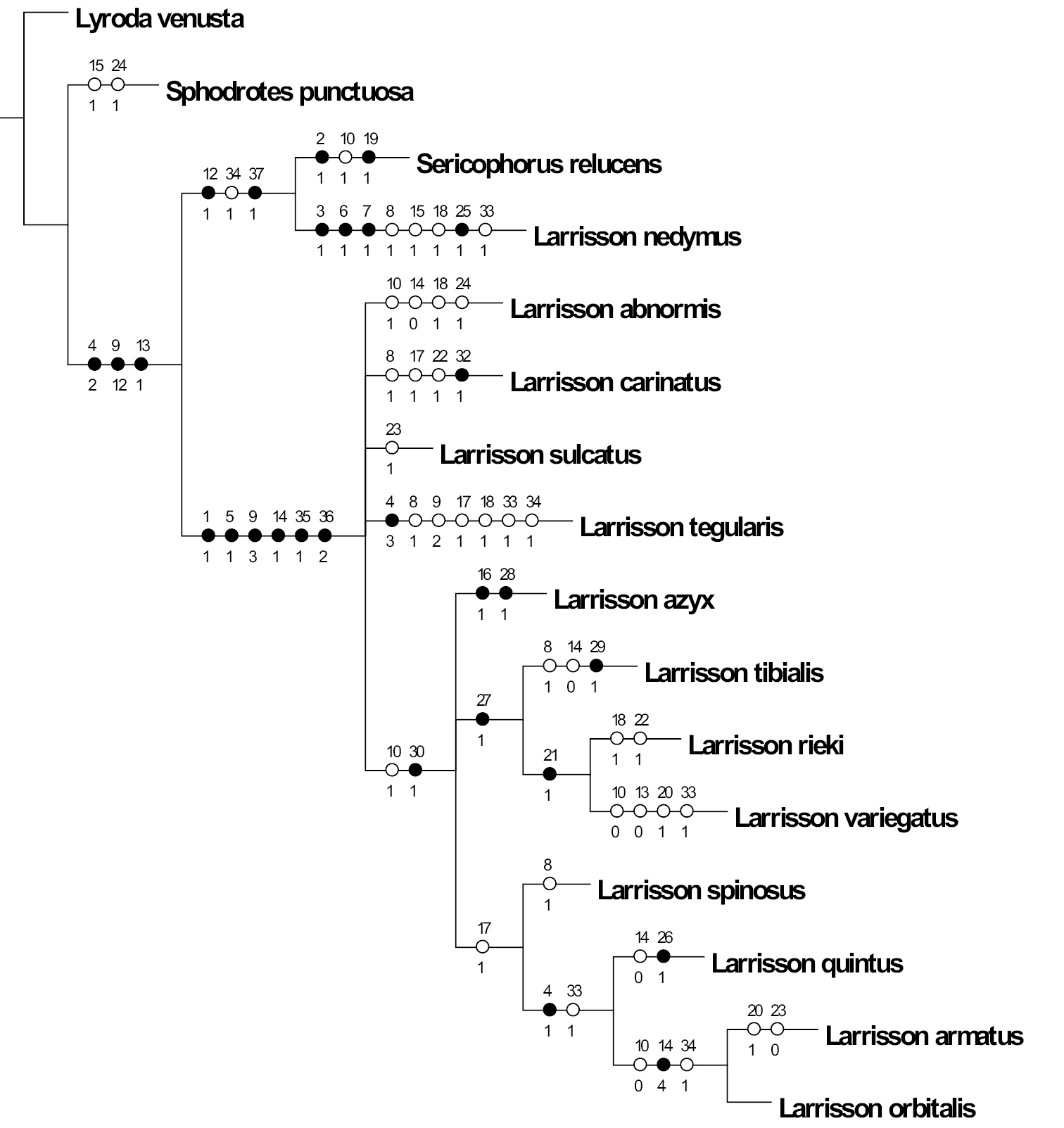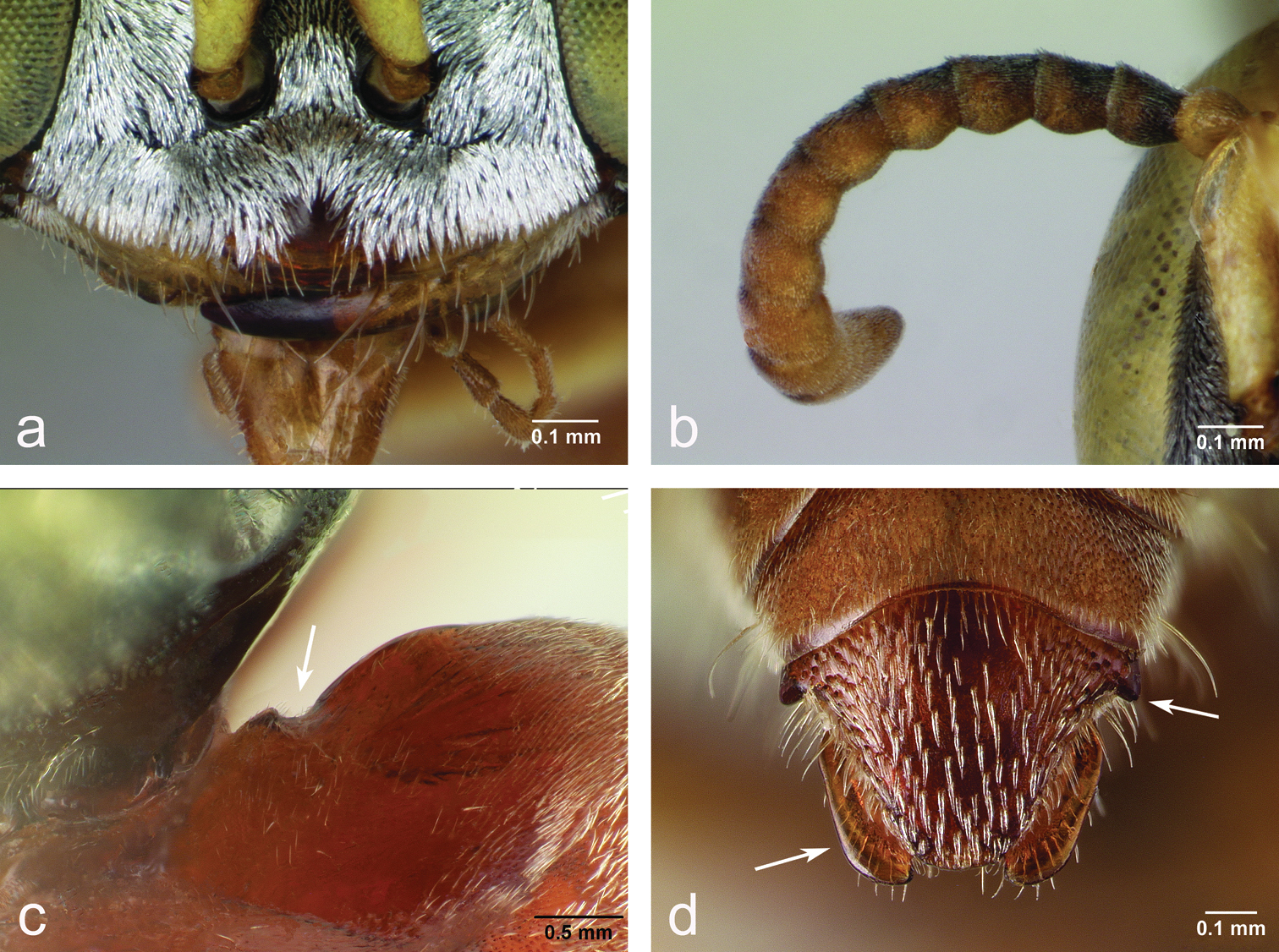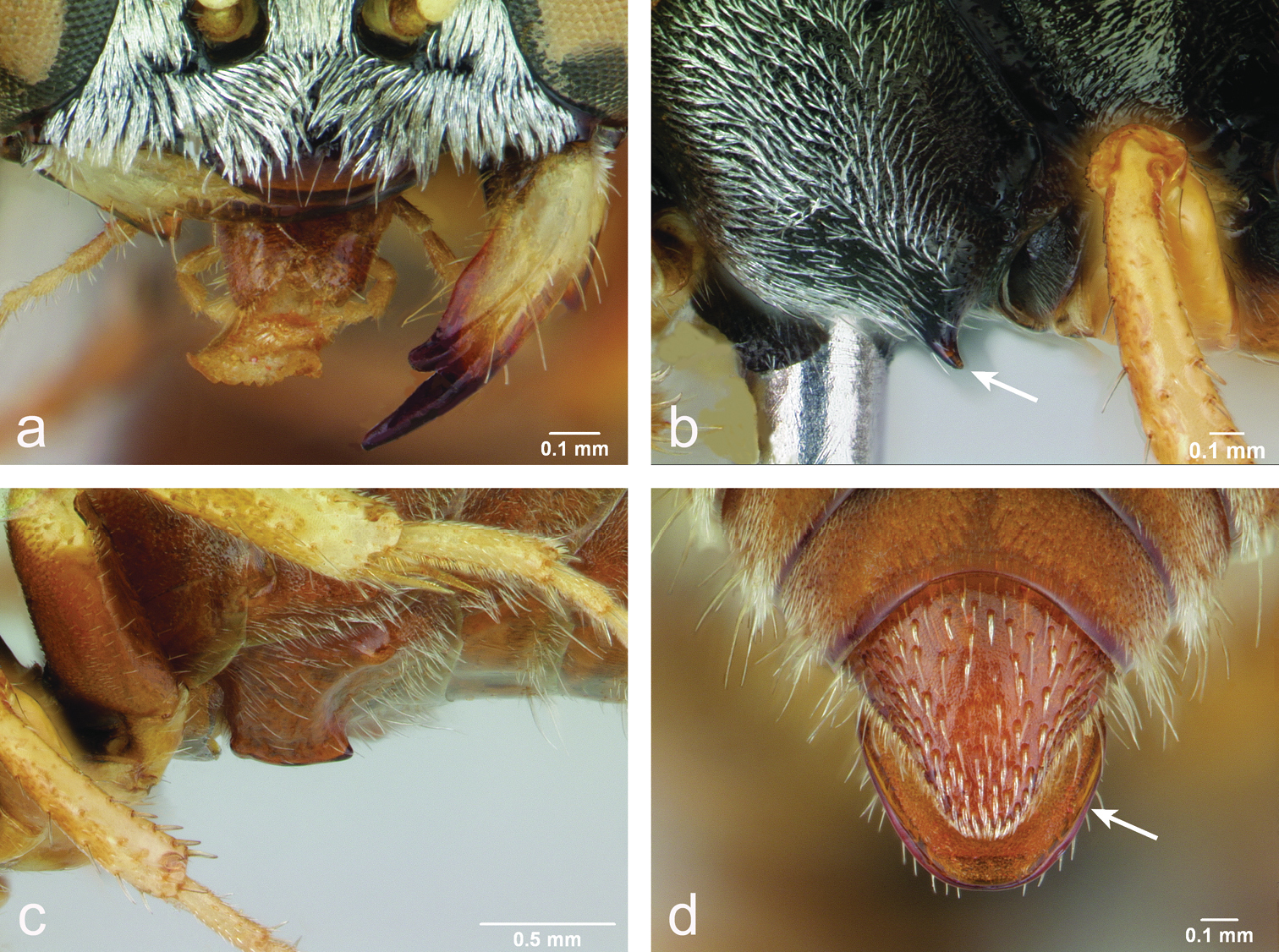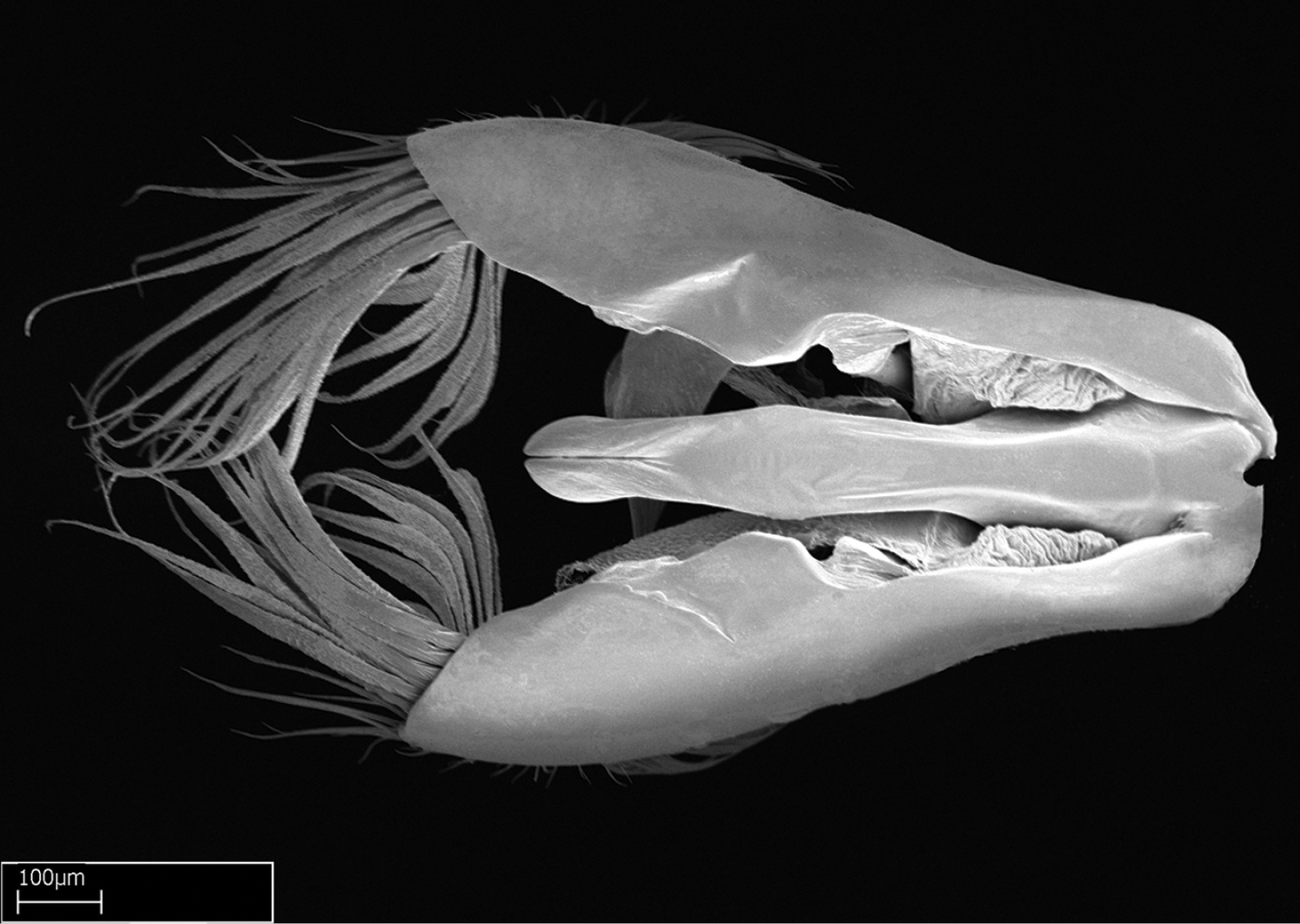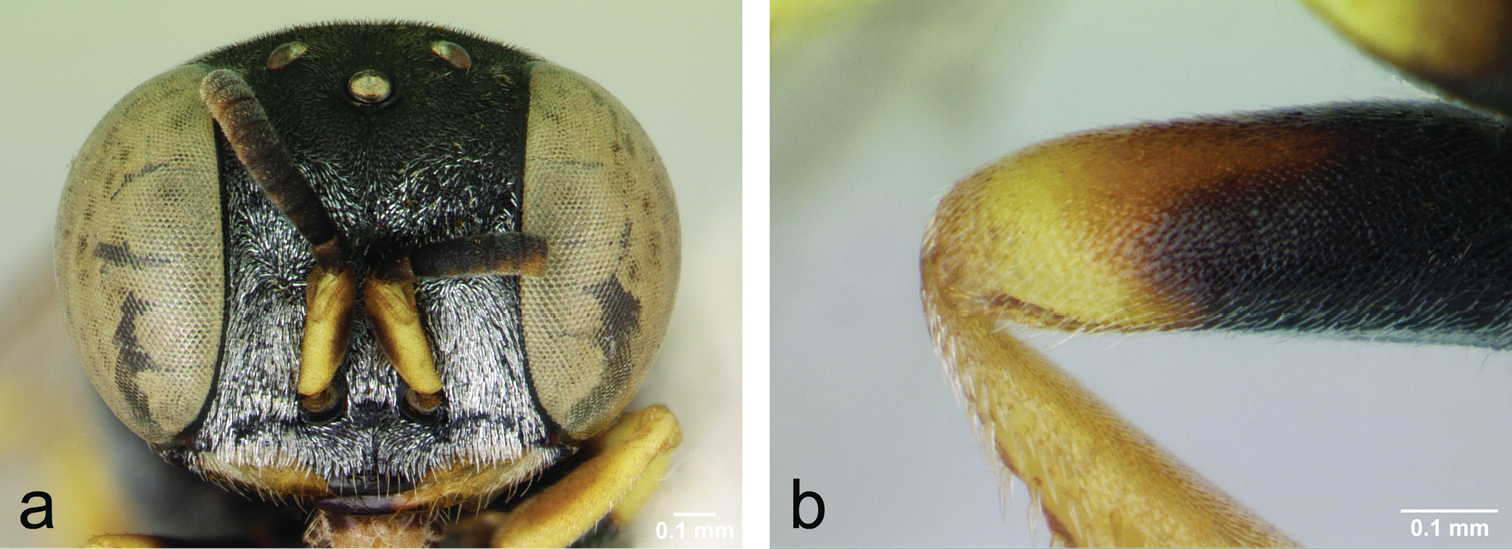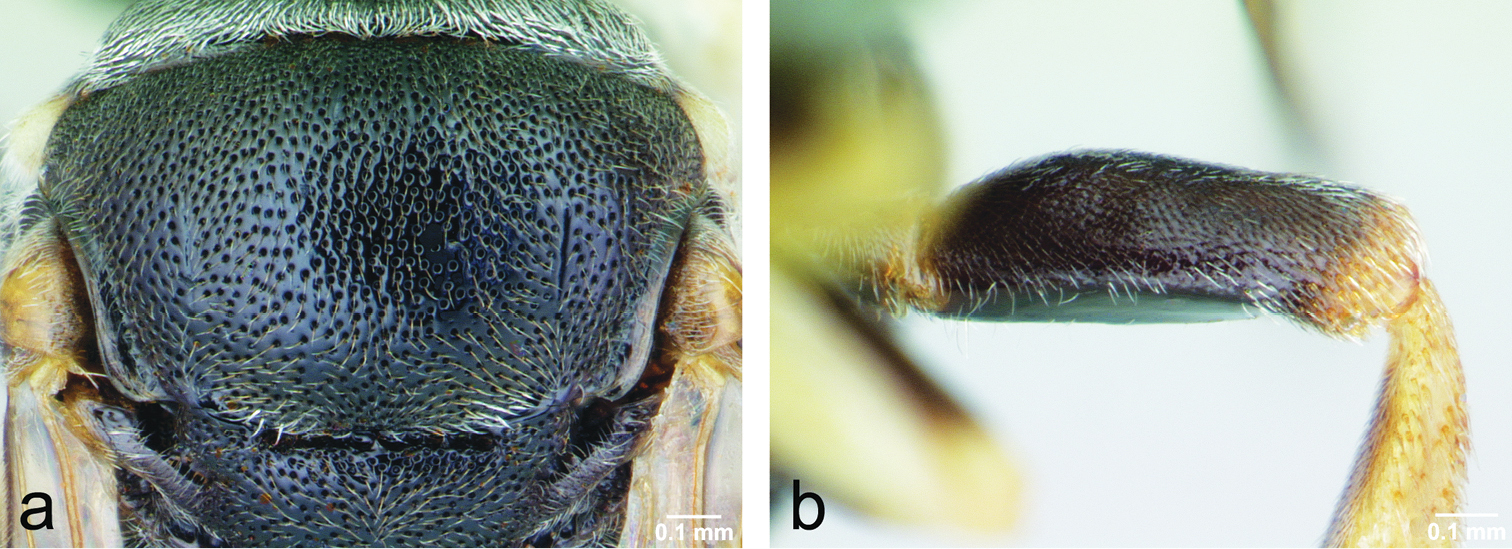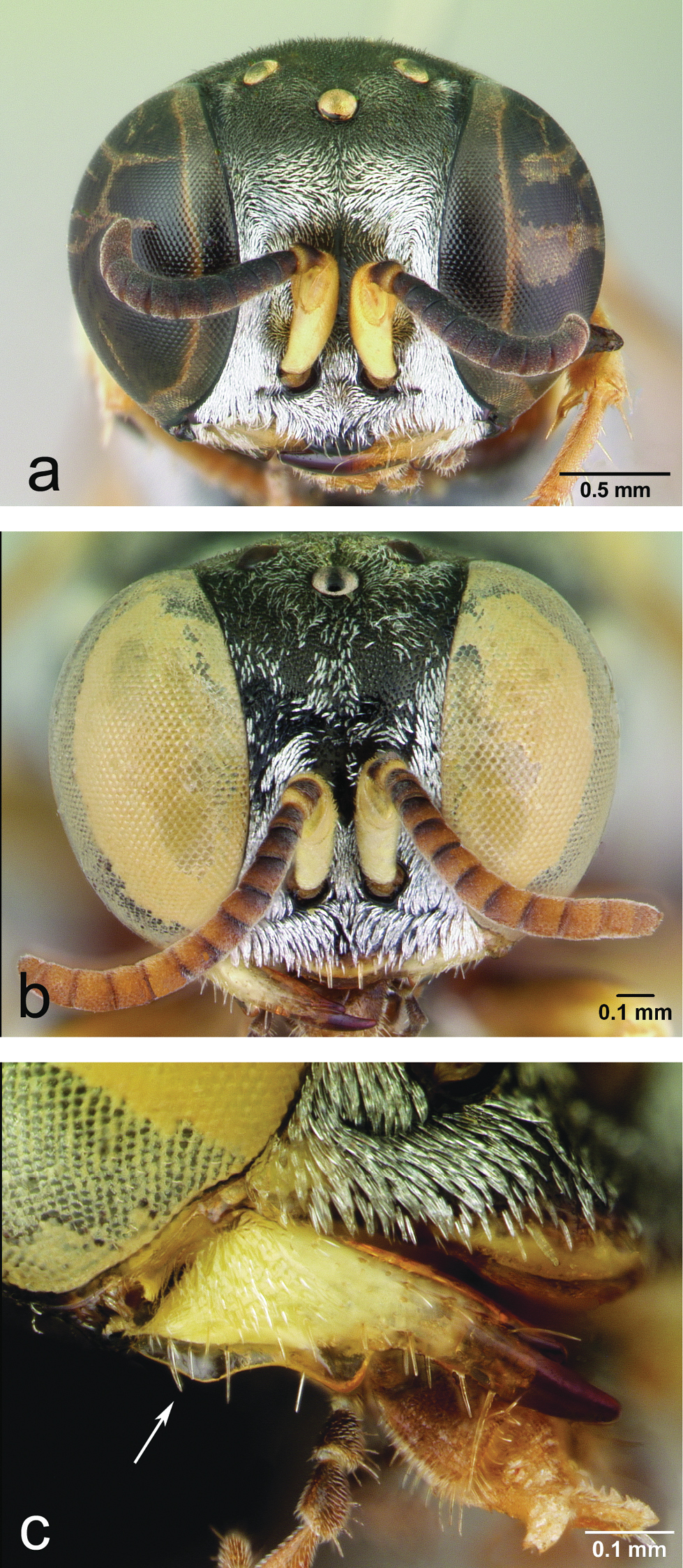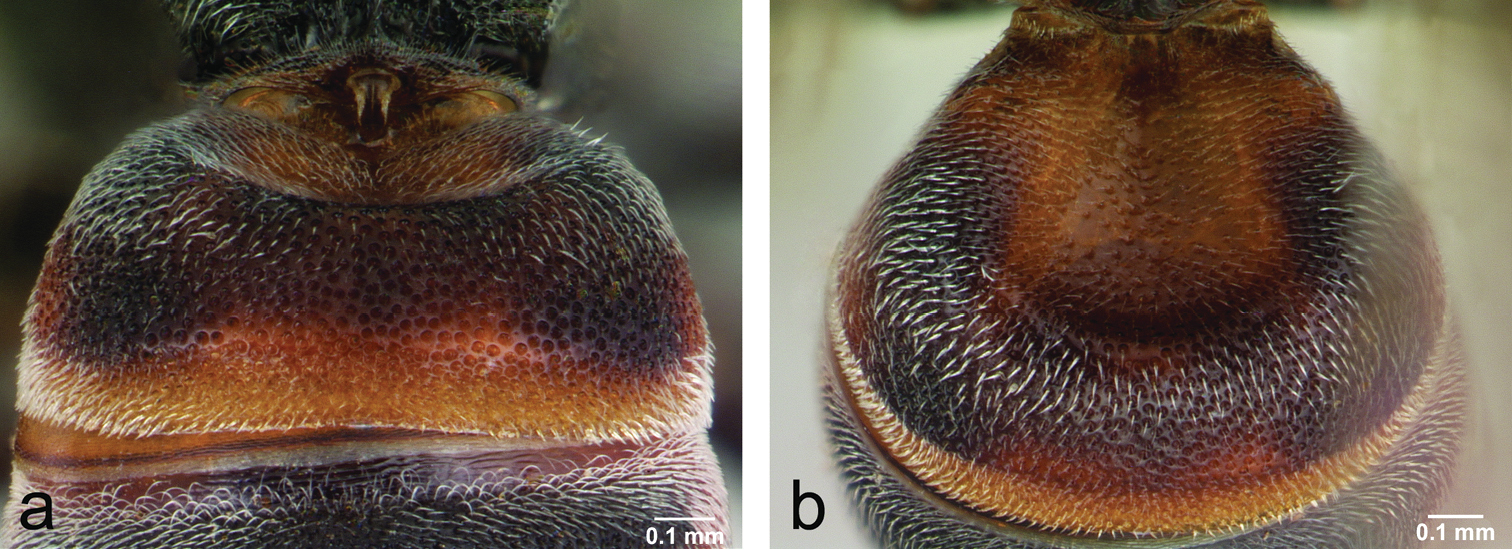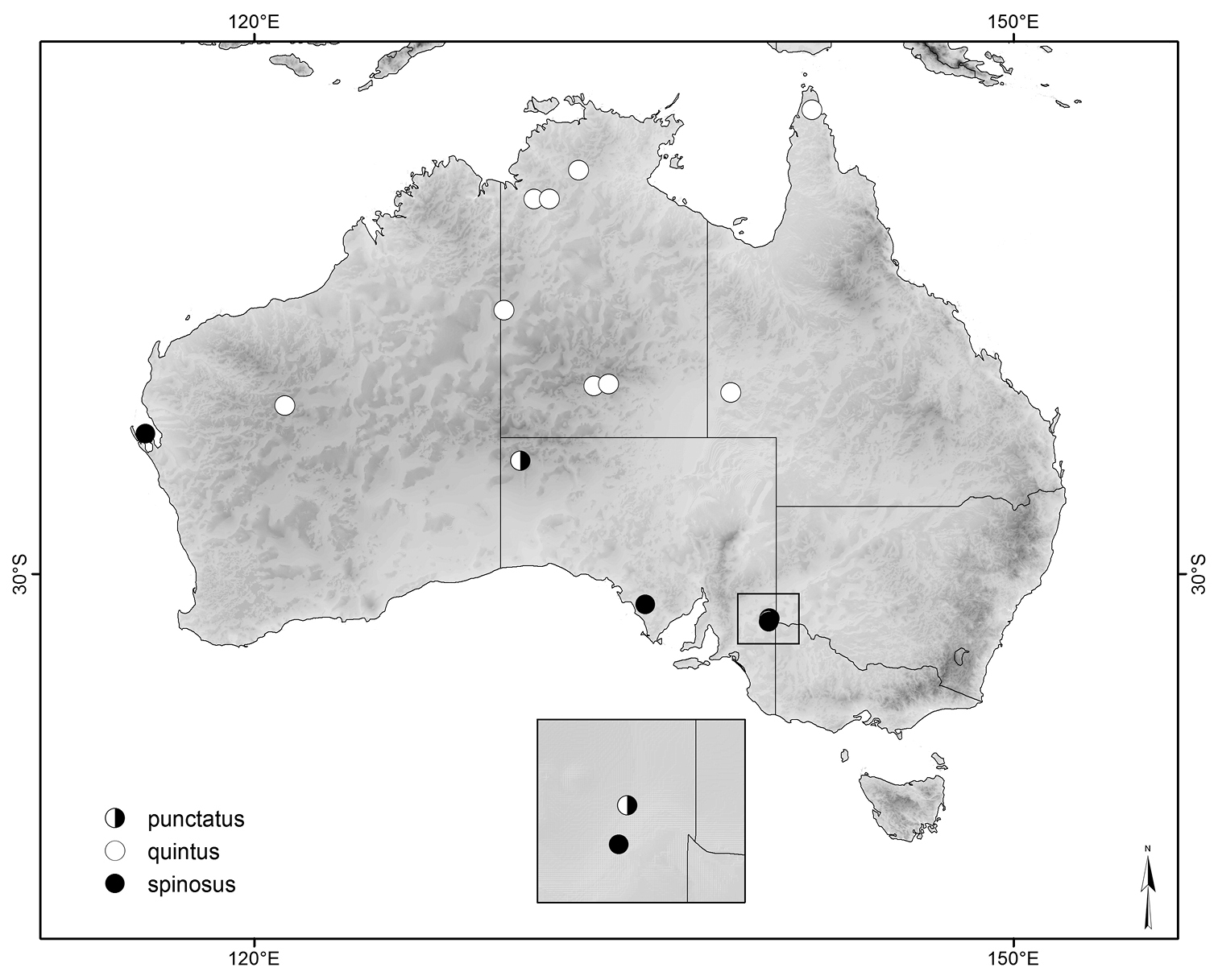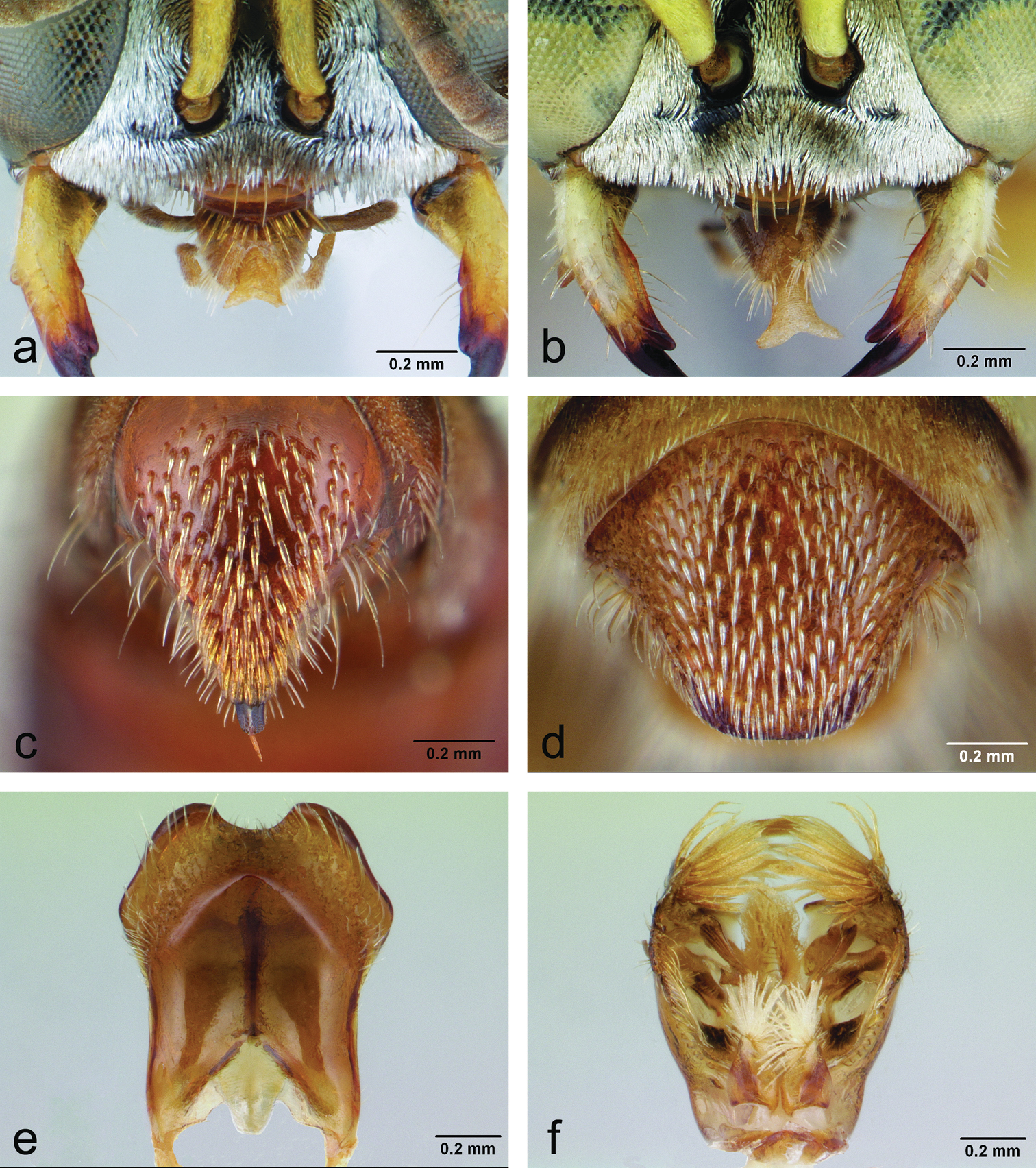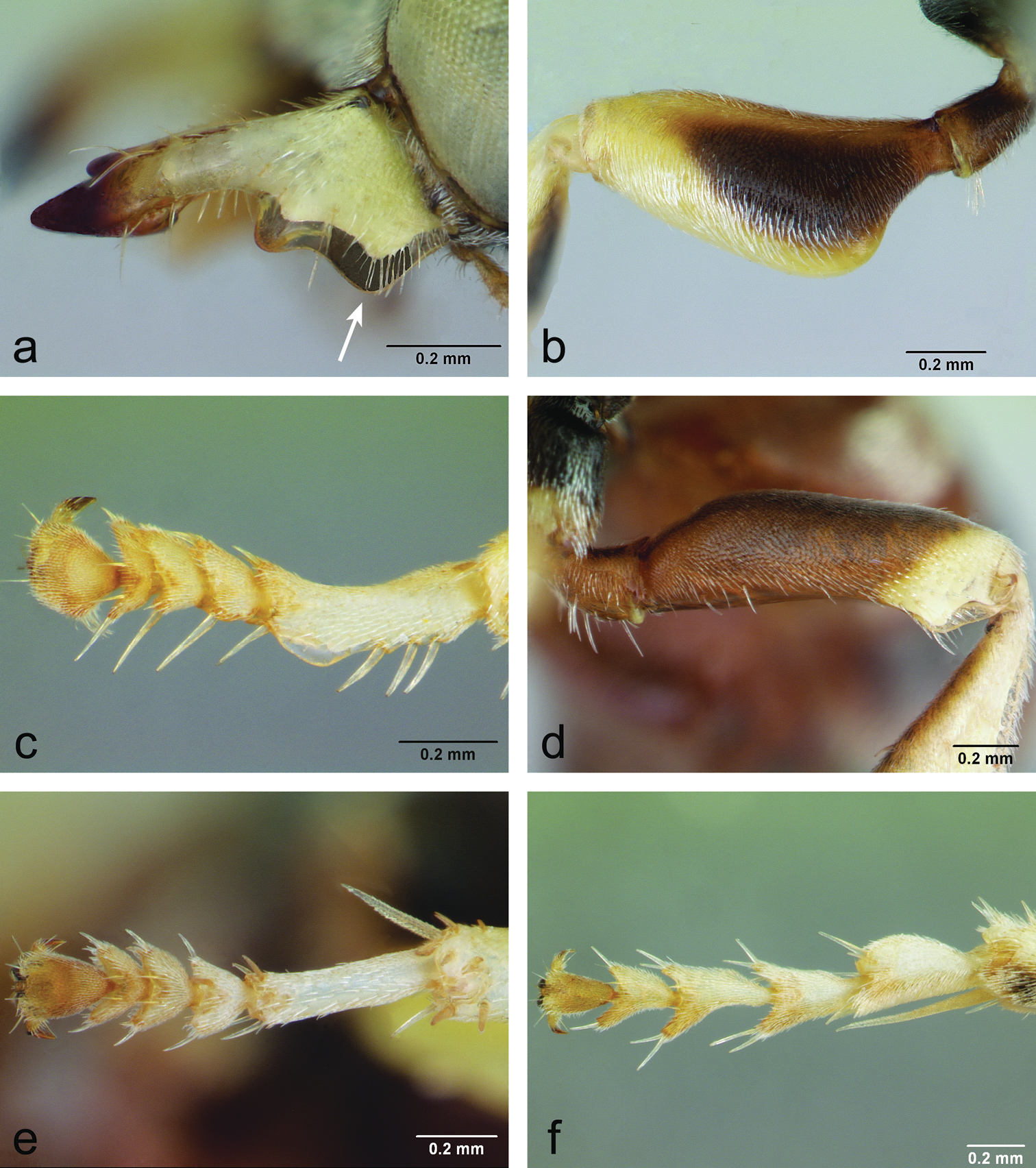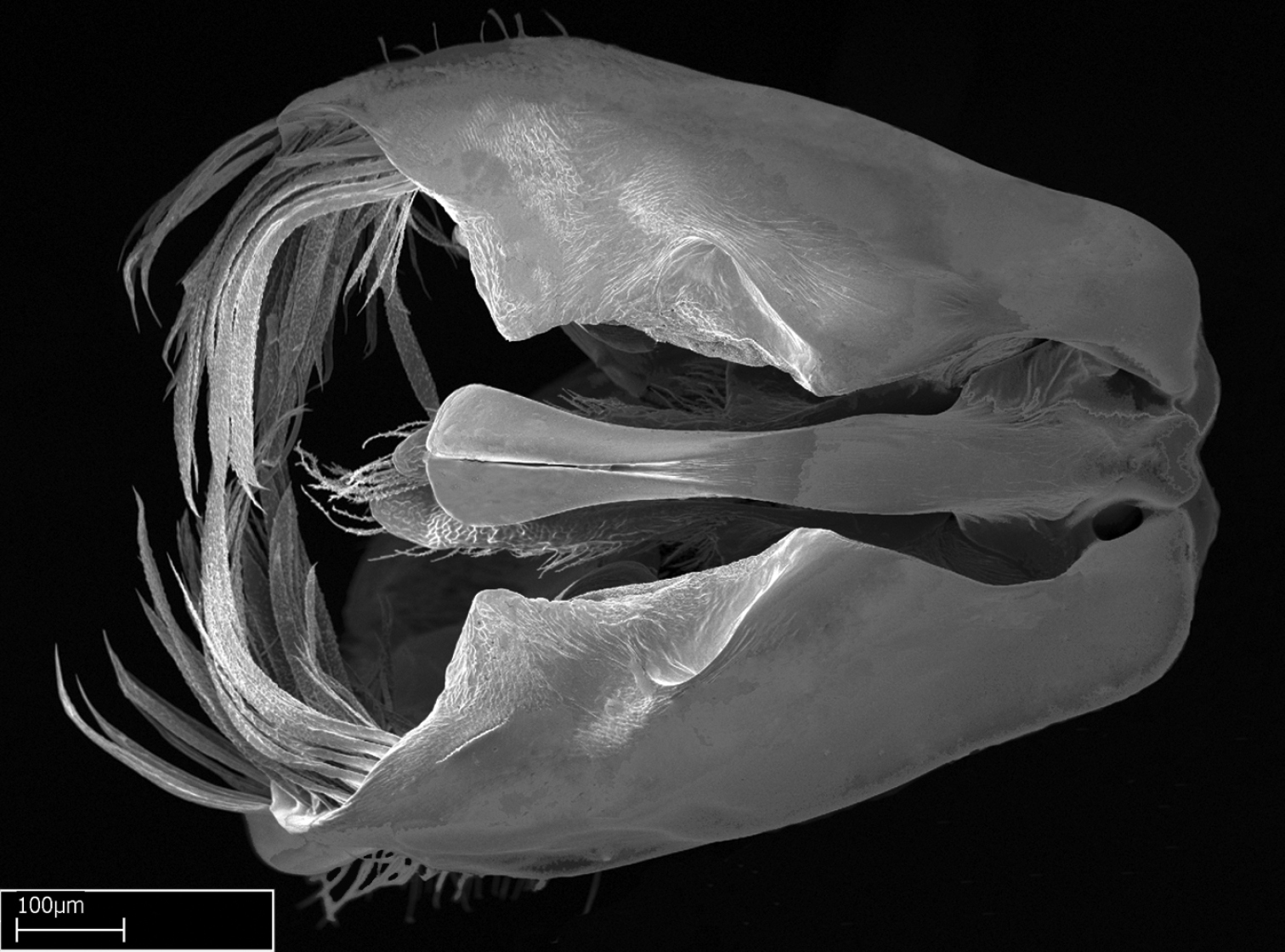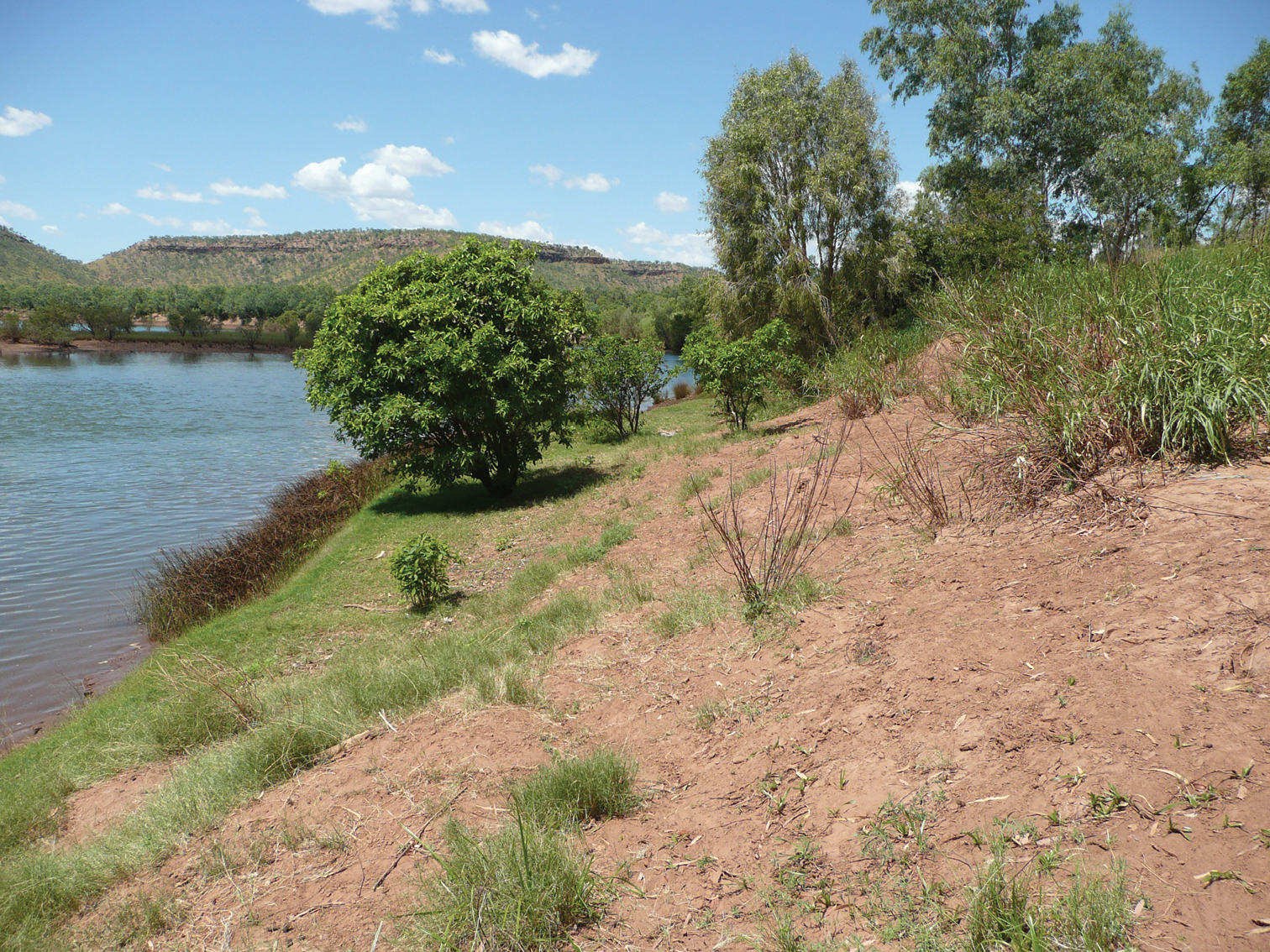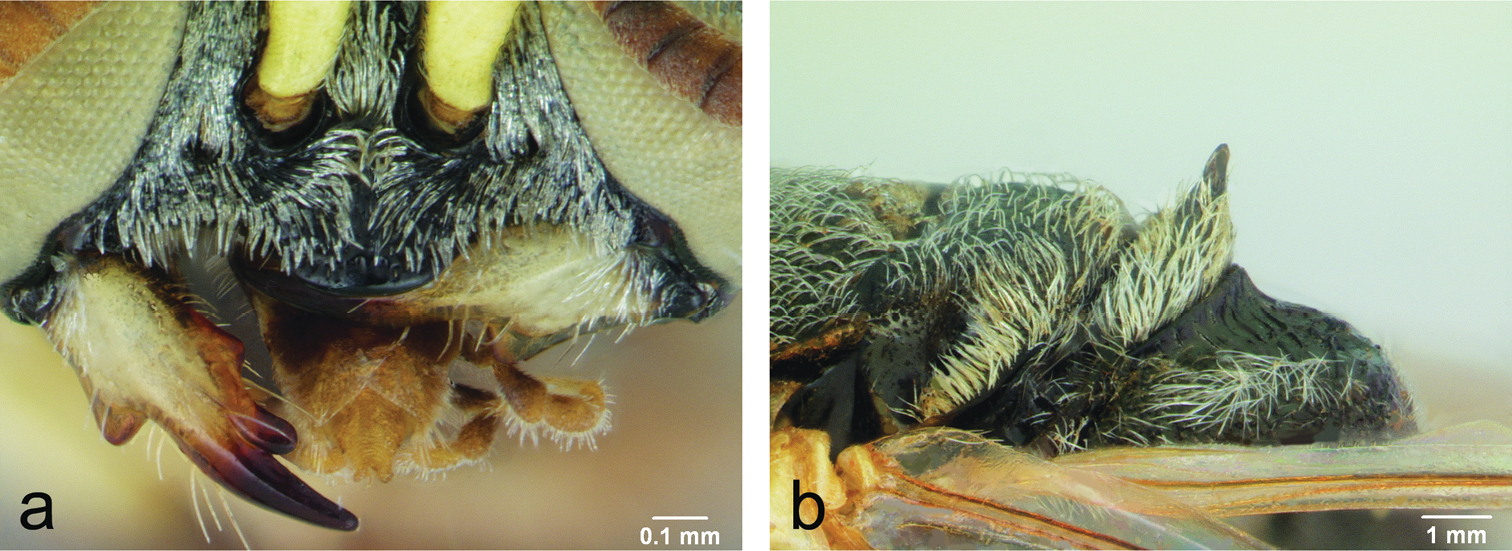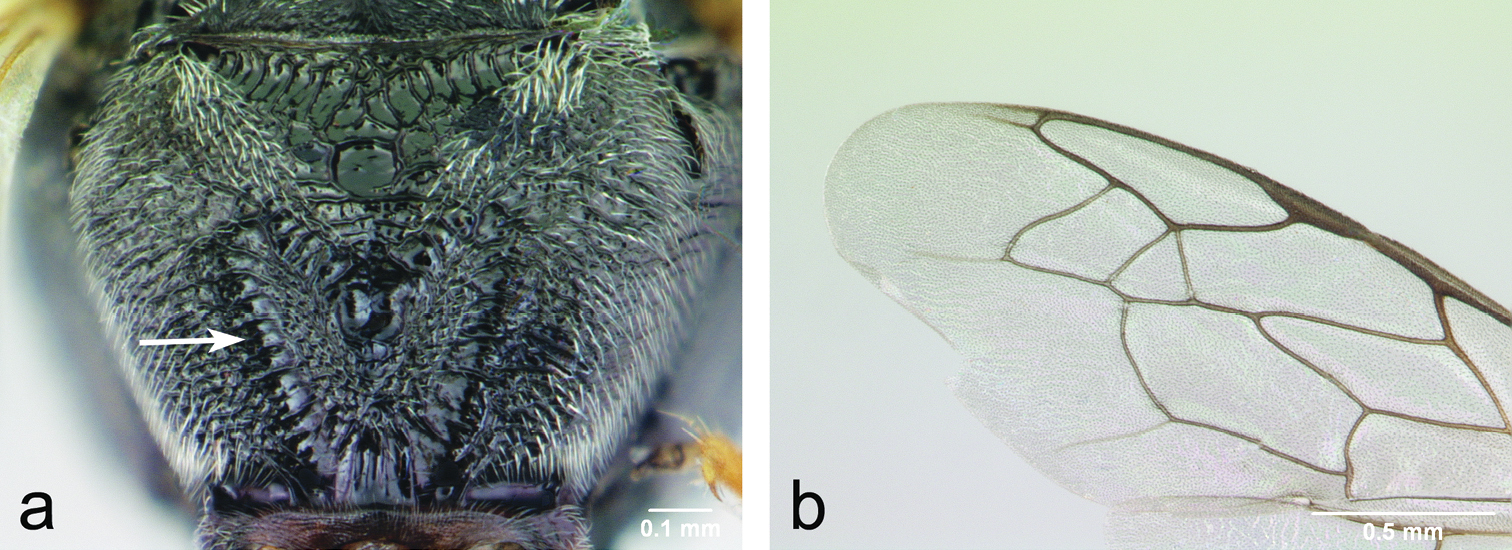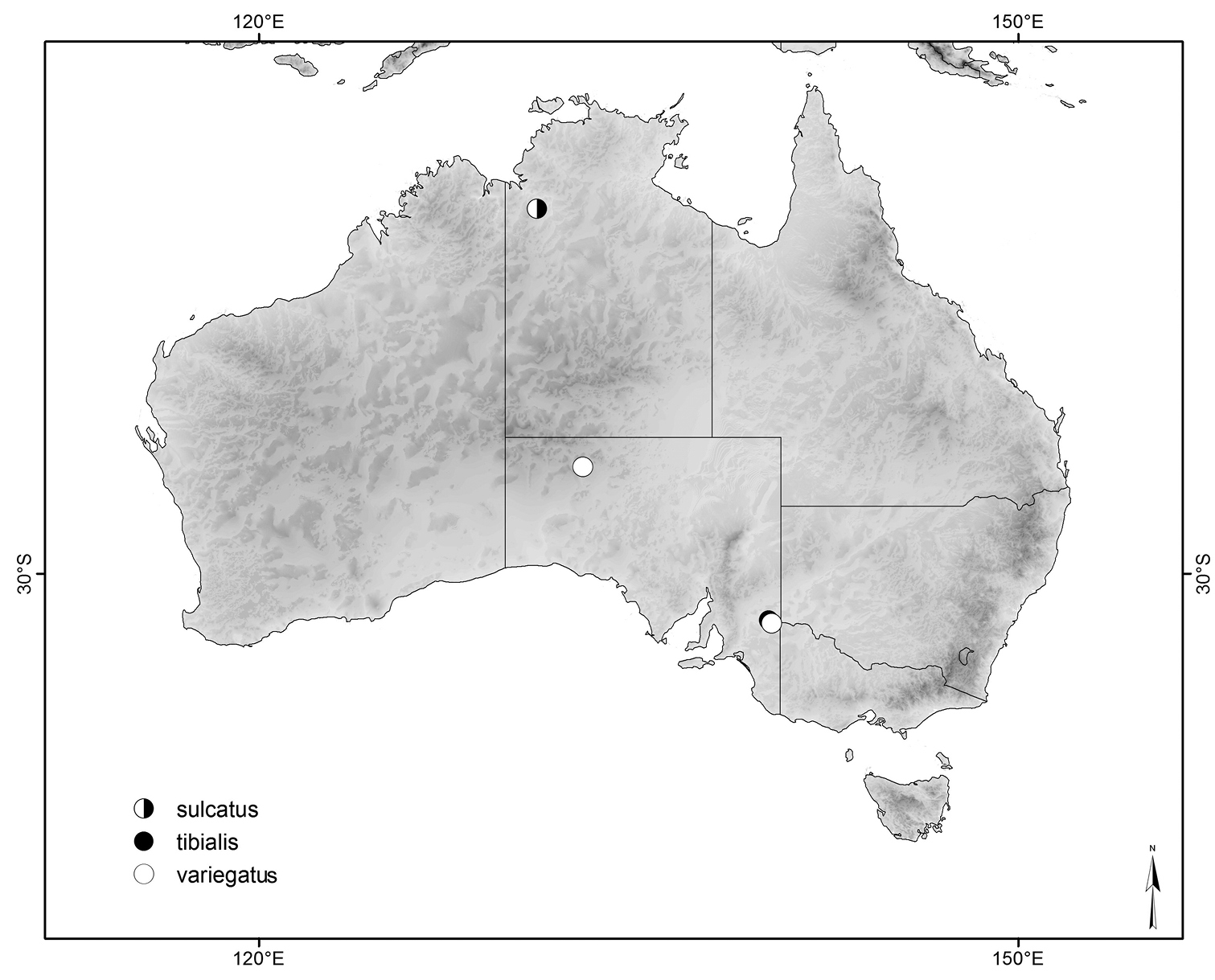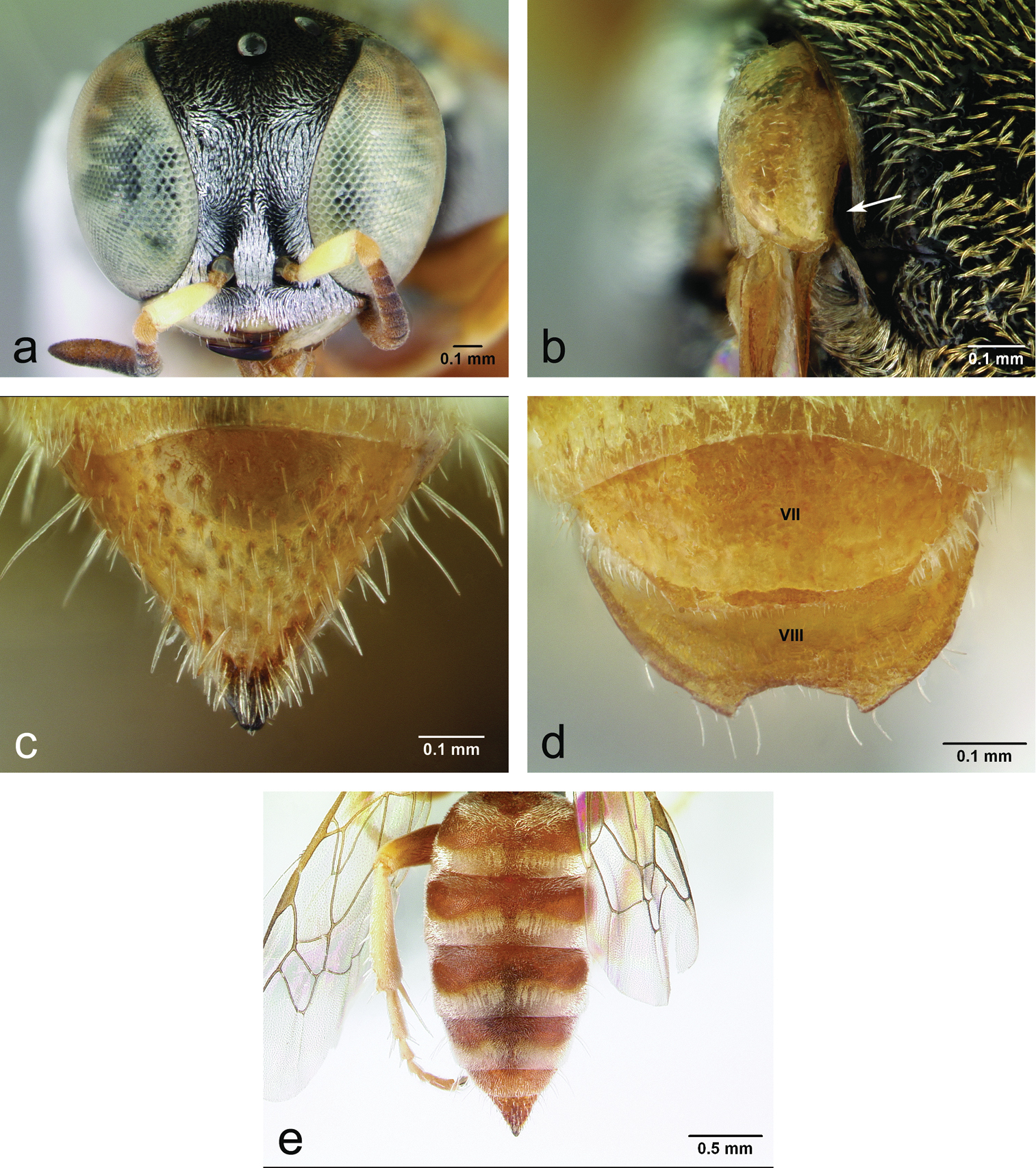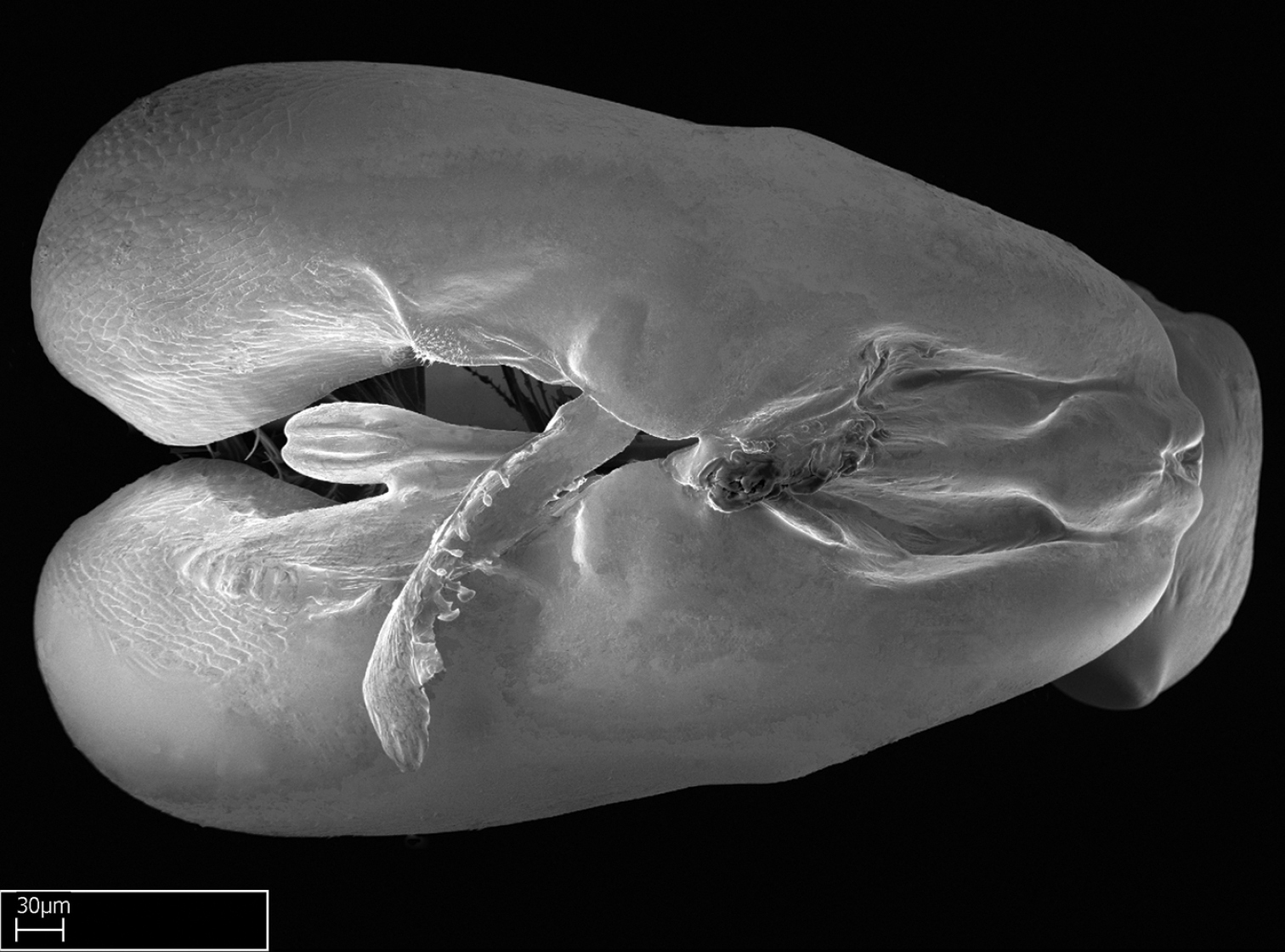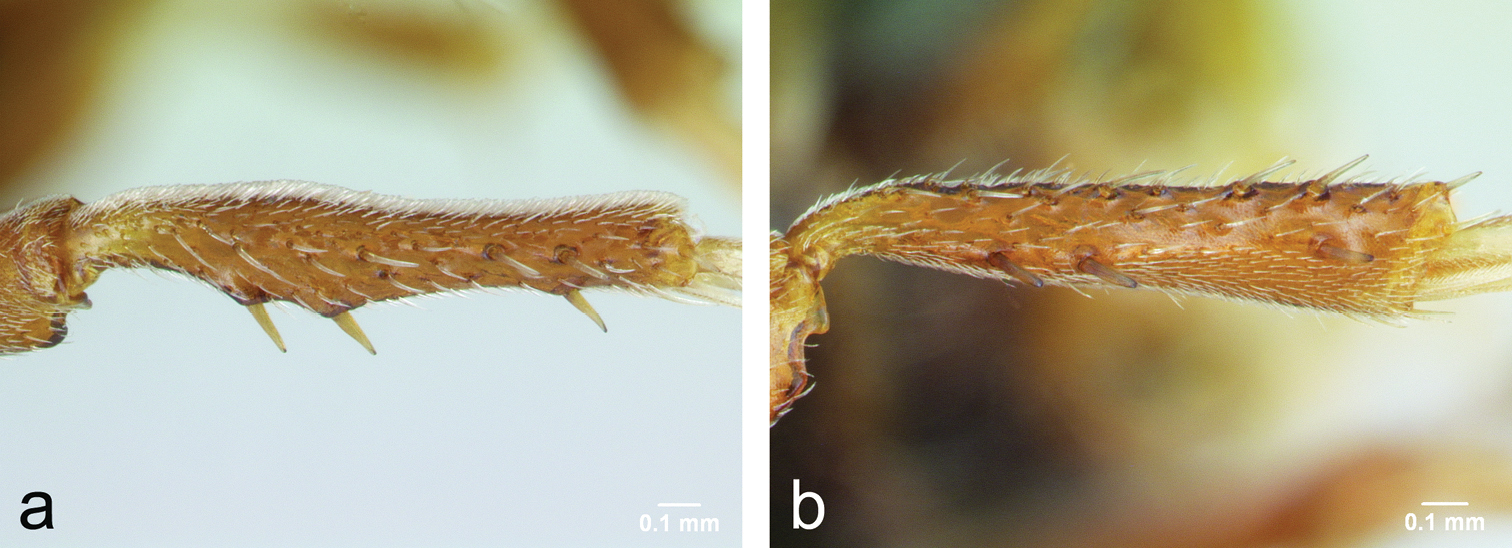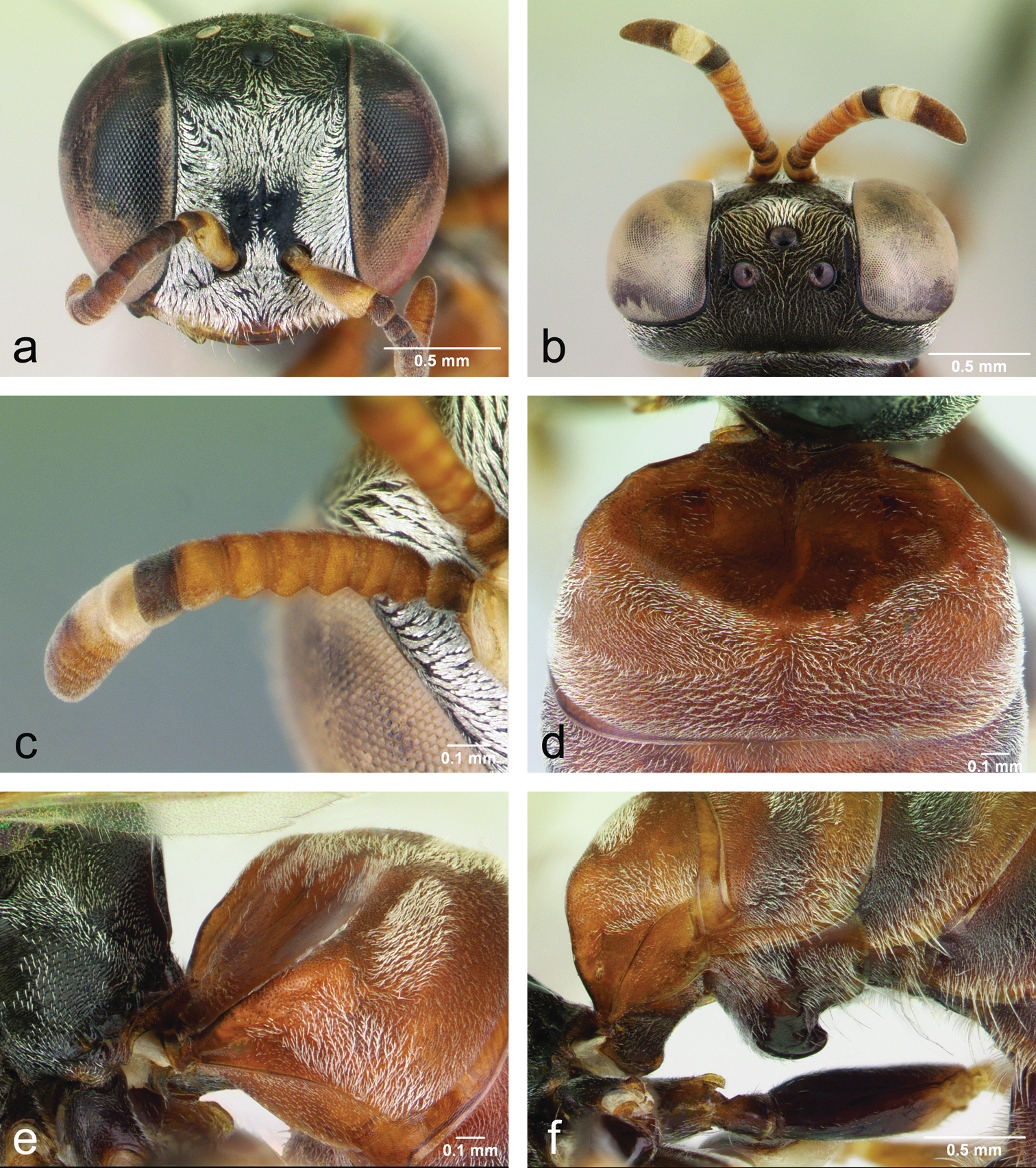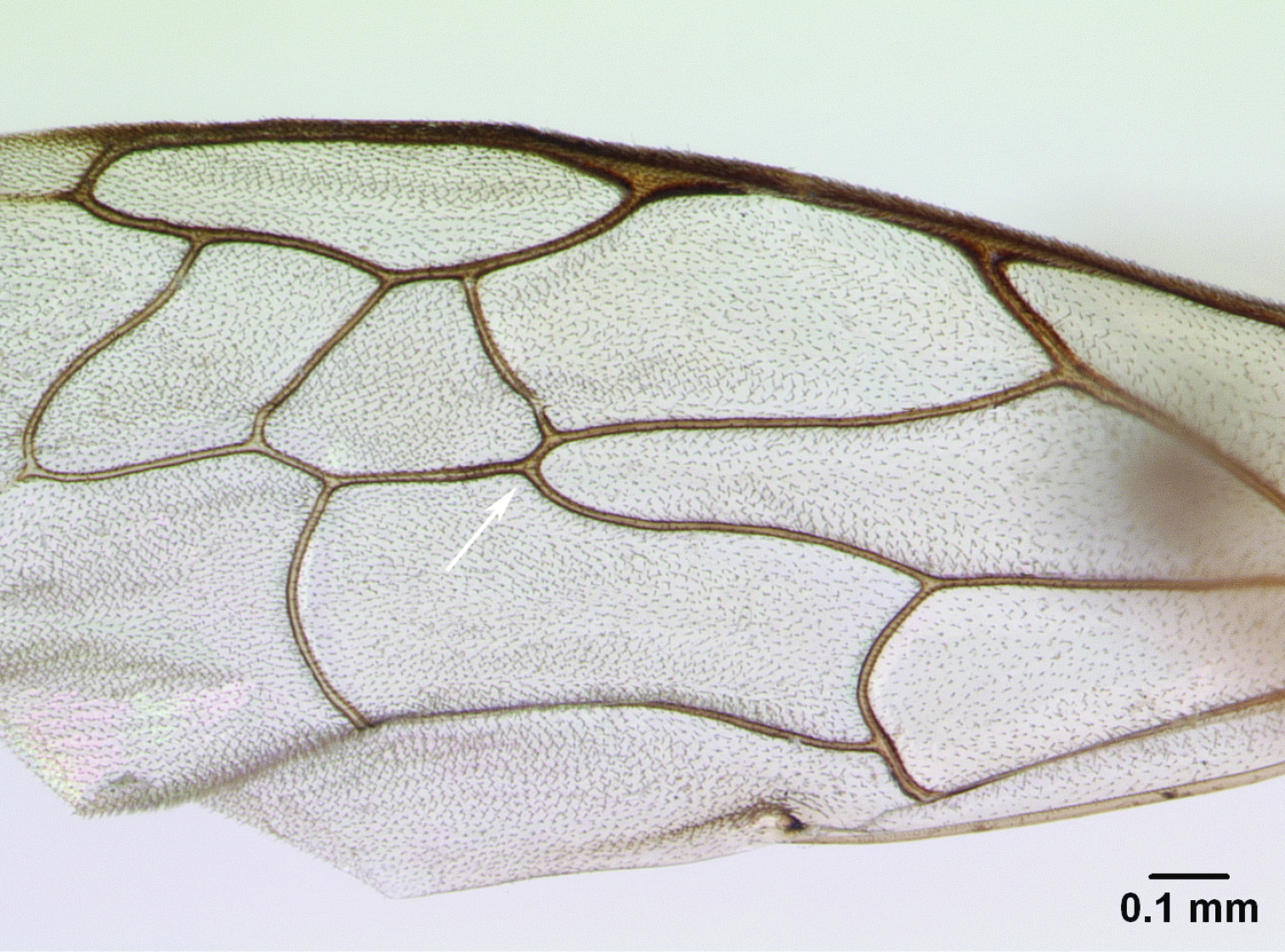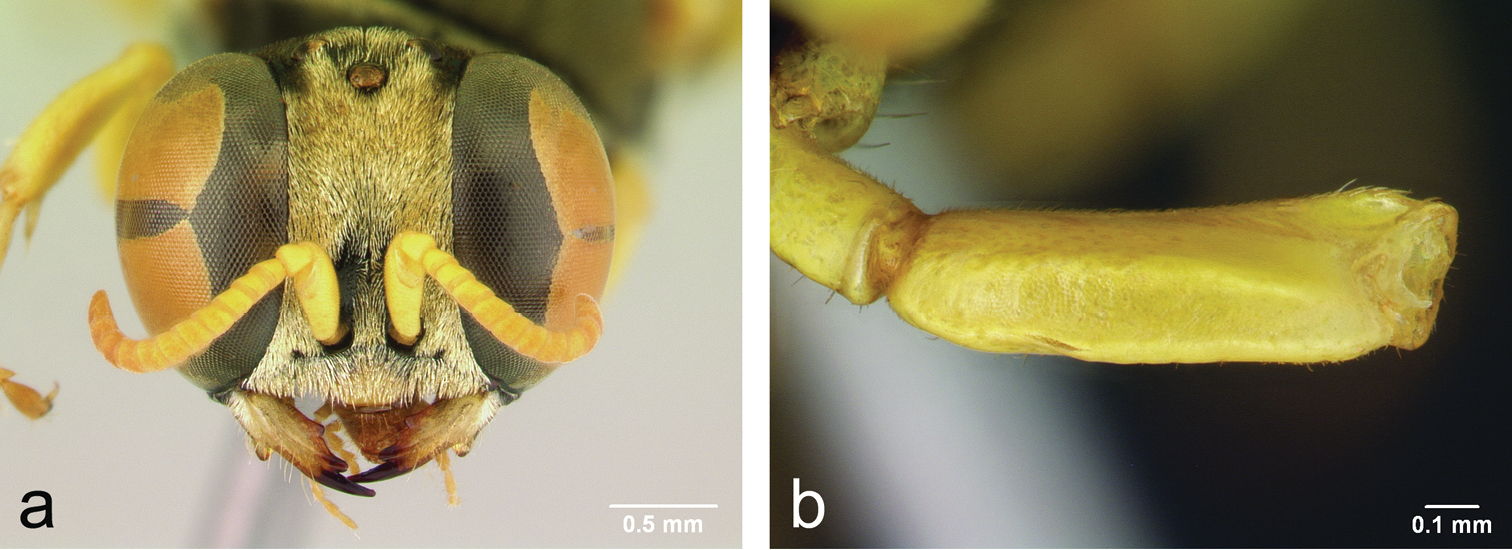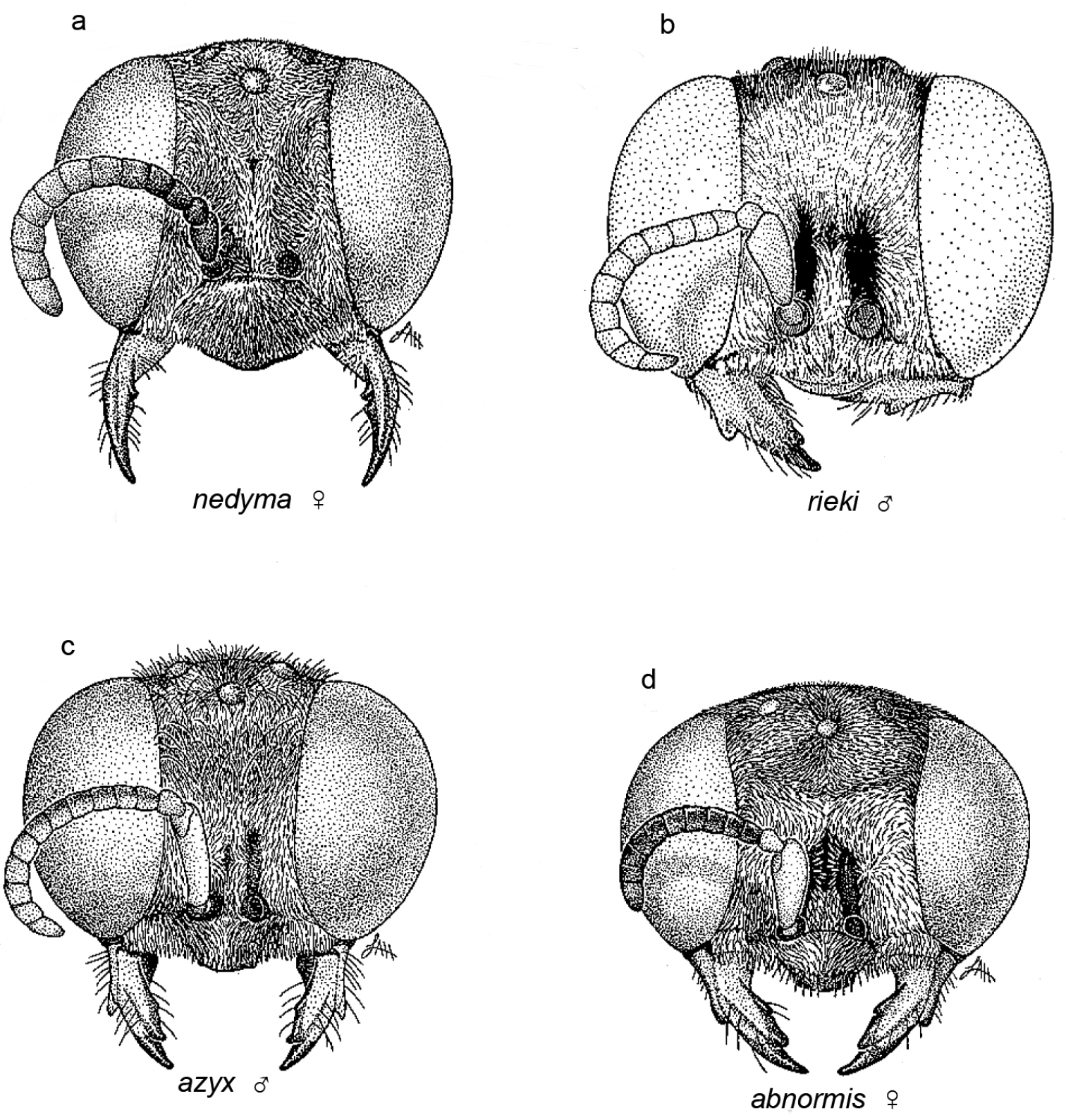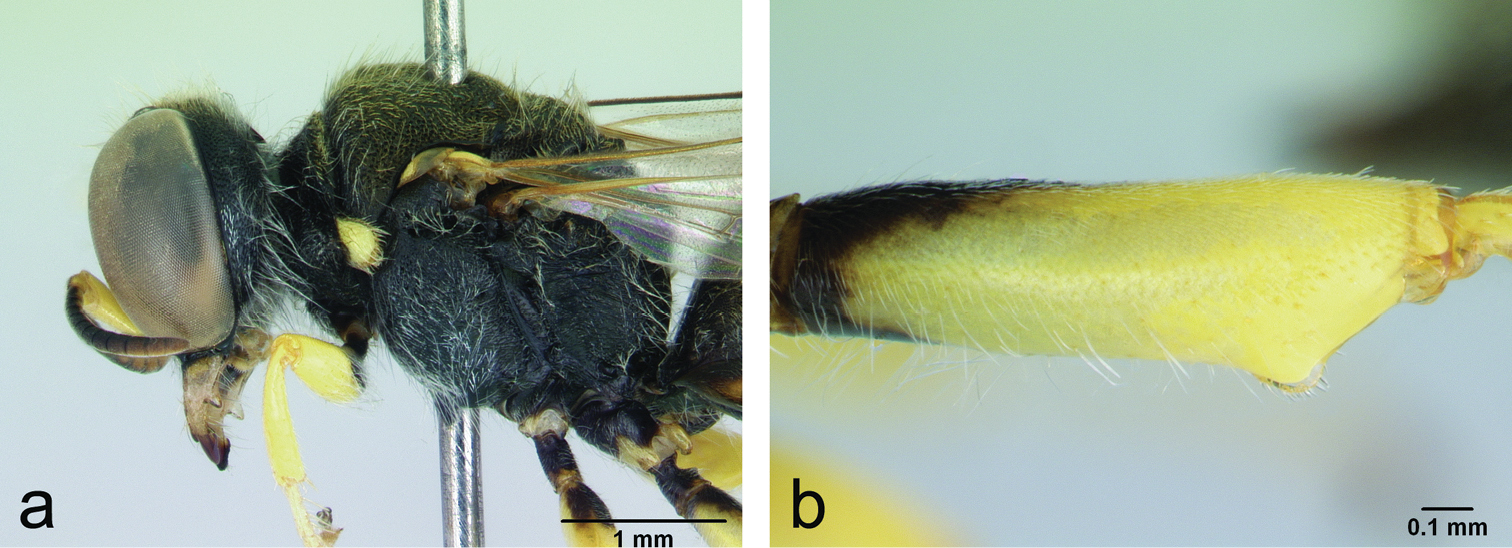






(C) 2012 Wojciech J. Pulawski. This is an open access article distributed under the terms of the Creative Commons Attribution License 3.0 (CC-BY), which permits unrestricted use, distribution, and reproduction in any medium, provided the original author and source are credited.
For reference, use of the paginated PDF or printed version of this article is recommended.
Larrisson menkei Pagliano, 1995, is transferred to Clitemnestra comb. n. and twelve new species of Larrisson are described: armatus, carinatus, latifrons, niger, orbitalis, punctatus, quintus, spinosus, sulcatus, tegularis, tibialis, and variegatus, all from Australia. Based on a cladistic analysis of the genus, Larrisson nedymus Menkeis transferred to Larrissa gen. n. Additional locality records are provided for Larrisson abnormis Turner, azyx Menke, rieki Menke, and for Larrissa nedyma (Menke). An updated key to the species of Larrisson and Larrissa is provided.
Taxonomy, revision, Larrisson, new genus, Larrissa
Larrisson isa little known, rarely collected, strictly Australian genus of the solitary wasp family Crabronidae. It was established for Sericophorus abnormis Turner, 1914 by
Little is known about the habits of Larrisson. I collected them in open habitats, exposed to the sun, on light, mainly sandy soils (as in Fig. 15). Certainly they nest in the ground, and the only prey record is a mirid.
Materials and methodsDuring my recent expeditions to Australia (Northern Territory, 3 March – 27 April 2008; Western Australia, 14 October – 13 December 2008; New South Wales, 1 December 2009 – 15 January 2010; South Australia, 1 December 2010 – 4 February 2011), I collected six new species of Larrisson, and visits to the Western Australian Museum, Perth, Western Australia (11-12 December 2008), Australian National Insect Collection, Canberra, Australian Capital Territory (20-24 April 2009), and South Australian Museum, Adelaide, South Australia (1-3 February 2011) revealed additional new species. Descriptions of the undescribed species are given below, as are additional locality records for four previously known species. I have examined specimens of all species of Larrisson and provide an updated key to species. I have also performed a cladistic analysis of the species of Larrisson, which demonstrates that Larrisson nedymus should be placed in a separate genus that I describe below under the name of Larrissa. As a result, Larrisson now totals 15 species, up from previously known three.
Specimens of Larrisson are rarely encountered, but Larrisson quintus is described from 100 specimens, the largest series ever collected of the genus. In comparison,
The morphological terminology follows
Abbreviations in the text include:
AMS Australian Museum, Sydney, New South Wales, Australia.
ANIC Australian National Insect Collection (CSIRO), Canberra, Australian Capital Territory, Australia.
BMNH The Natural History Museum (formerly British Museum Natural History), London, United Kingdom.
CAS California Academy of Sciences, San Francisco, California, USA.
OHL Michael Ohl, Berlin, Germany (personal collection).
QMB Queensland Museum, Brisbane, Queensland, Australia.
SAM South Australian Museum, Adelaide, South Australia, Australia
USNM United States National Museum of Natural History, Washington, D.C., USA.
USU Utah State University, Logan, Utah, USA.
WAMP Western Australian Museum, Perth, Australia.
WMNP West MacDonnell National Park, Northern Territory, Australia.
Results The holotype has typical gorytine characters (
In his key to world genera of Miscophini,
Prey of Larrisson was unknown until now, but the holotype female of niger is pinned with her prey, an adult mirid 3.6 mm long. The specimen has an additional label that reads “Wasp grasped bug on terete-leaved Acacia”, indicating that the mirid was not placed on the same pin accidentally. Randall T. Schuh (American Museum of Natural History, New York, New York) kindly identified it as a male of the tribe Orthotylini belonging to an undescribed genus and species.
1. Frons: 0, fully setose. 1, with glabrous scapal basin.
2. Occipital carina: 0, not reaching hypostomal carina. 1, reaching hypostomal carina.
3. Scape: 0, not shortened, length (without radix) at least 1.8 × width. 1, shortened, length about 1.3 × width (Fig. 25a).
4. Length of flagellomere I: 0, at least 1.7 × apical width. 1, about 1.3–1.5 × apical width. 2, about equal to apical width. 3, about 0.8 × apical width.
5. Mandible, inner margin: 0, without tooth at midlength of inner margin. 1, with tooth at midlength of inner margin (Fig. 25a).
6. Mesopleuron: 0, rounded anteriorly. 1, abruptly angular below pronotal lobe.
7. Mesothoracic venter (shape): 0, inconspicuously concave. 1, conspicuously concave.
8. Mesothoracic venter (sculpture): 0, densely punctate. 1, sparsely punctate.
9. Propodeal dorsum (setae): 0, all setose. 1, median sulcus glabrous. 2, median sulcus and adjacent area glabrous. 3, all enclosure (or nearly so) glabrous.
10. Presence of spine or tubercle behind propodeal spiracle: 0, spine or tubercle absent. 1, present (the spine in Sphodrotes punctuosa is much further from the spiracle and thus nonhomologous with that of Larrisson).
11. Posterior propodeal surface: 0, without medioventral carina. 1, with medioventral carina.
12. Divergence of forewing vein M from M+Cu: 0, diverging distad of cu-a or interstitial with cu-a. 1, diverging basad of cu-a.
13. First recurrent vein: 0, ending on second submarginal cell (Fig. 23) or interstitial with first intersubmarginal vein. 1, ending on first submarginal cell.
14. Hindtibial outer surface: 0, all or largely punctate and setose (at least sparsely so). 1, impunctate and asetose between spines in dorsal half or along dorsal margin, at least in apical half.
15. Basolateral carina of tergum I: 0, not expanded. 1, expanded into lamella.
16. Setae: 0, appressed. 1, erect or suberect on upper frons, gena, vertex, mesothorax, hindcoxal venter, and hindfemoral venter (Fig. 27a, b).
17. Color of gaster: 0, gaster all or largely black 1, gaster all or largely red (Fig. 19e).
18. Presence of yellow fasciae on gaster: 0, fasciae absent. 1, fasciae present.
19. Male flagellum (number of flagellomeres): 0, with 11 flagellomeres. 1, with 10 flagellomeres (10 flagellomeres are found in all Sericophorus).
20. Male flagellum (shape): 0, flagellomeres all cylindrical. 1, flagellomeres I–VI convex ventrally (Fig. 22c).
21. Male flagellum (color): 0, black or dark brown or reddish brown ventrally. 1, at least flagellomeres VIII and IX yellow (Figs 22b, c, 24a).
22. Mesopleural precoxal carina of male: 0, low, obtuse. 1, projecting as spine.
23. Male metanotum: 0, simple. 1, with median spine or tubercle (Fig. 16b).
24. Male propodeum(presence of spine or tubercle behind spiracle): 0, spine or tubercle absent. 1, spine or tubercle present (the tubercle in Sphodrotes punctuosa is minute, and a lower one, large, is nonhomologous).
25. Male forecoxa and foretrochanter: 0, not modified. 1, modified.
26. Male femora, tibiae, and tarsi: 0, not modified. 1, modified (Fig. 26b-f).
27. Male midfemur: 0, convex ventrally, not carinate. 1, slightly concave ventrally, with obtuse carina along both anterior and posterior margin (Fig. 27b).
28. Male hindfemur: 0, without process. 1, with ventral preapical process (Fig. 27b).
29. Outer surface of male hindtibia (shape): 0, not swollen. 1, swollen in basal third or so (Fig. 21a).
30. Transverse swelling on male sternum II: 0, absent or rudimentary. 1, well defined.
31. Tergum VII: 0, without basolateral tooth. 1, with basolateral tooth (Fig. 2d).
32. Longitudinal carina on male sternum II: 0, carina absent. 1, carina present in basal half (Fig. 22f).
33. Male sternum VIII (apex): 0, not emarginate apicomesally. 1, emarginate apicomesally.
34. Male sternum VIII (apicolateral emargination): 0, absent. 1, present (Fig. 2d, 12e, 19d).
35. Gonocoxite: 0, with simple, short setae. 1, with elaborate, setal fringes (Fig. 5, 14).
36. Volsella: 0, minimal to absent. 1, present, about half length of penis valve. 2, present, about as long as penis valve.
37. Penis valve: 0, not dentate. 1, dentate.
The following data matrix (Table 1) was constructed using Winclada version 1.00.08 (
Character States of Larrisson and the Outgroup.
| Species | Characters | |||
|---|---|---|---|---|
| Lyroda venusta | 0000000000 | 1000000000 | 0000000000 | 0010000 |
| Sphodrotes punctuosa | 0000000000 | 1000100000 | 0001000000 | 0000000 |
| Sericophorus relucens | 0102000011 | 1110000010 | 0000000000 | 0001001 |
| Larrisson abnormis | 1002100031 | 0010000100 | 0001000000 | 0000120 |
| Larrisson armatus | 1001100030 | 0014001001 | 0000000001 | 0011120 |
| Larrisson azyx | 1002100031 | 0011010000 | 0011000101 | 0000120 |
| Larrisson carinatus | 1002100130 | 0011001000 | 0100000000 | 0100120 |
| Larrisson nedymus | 0012011120 | 0110100100 | 0000100000 | 0011011 |
| Larrisson orbitalis | 1001100030 | 0014001000 | 0010000001 | 0011120 |
| Larrisson quintus | 1001100031 | 0010001000 | 0011010001 | 0010120 |
| Larrisson rieki | 1002100031 | 0011000100 | 1101001001 | 0000120 |
| Larrisson spinosus | 1002100131 | 0011001000 | 0010000001 | 0000120 |
| Larrisson sulcatus | 1002100030 | 0011000000 | 0010000000 | 0000120 |
| Larrisson tegularis | 1003100120 | 0011001100 | 0000000000 | 0011020 |
| Larrisson tibialis | 1002100131 | 0010000000 | 0001001011 | 0000120 |
| Larrisson variegatus | 1002100030 | 0001000001 | 1010001001 | 0010120 |
The above data matrix was analyzed using the Willi Hennig Society edition of TNT (
Strict consensus cladogram of the species of Larrisson based on male characters (Larrisson latifrons, niger, orbitalis, and punctatus, known from the female only, are omitted). Character numbers are placed above circles, with the state number below. Black circles indicate an unambiguous change, open circles indicate homoplastic change.
urn:lsid:zoobank.org:act:5982CB82-B235-444D-9312-F6DF05C6EE83
http://species-id.net/wiki/Larrisson_armatus
Figs 2, 3Armatus is a Latin masculine adjective meaning armed, with reference to the lateral spines on male tergum VII.
Larrisson armatus is unique in having the impunctate, medioventral area of the clypeus narrow and elongate, extending dorsally to the clypeal midlength of more. The male is also unique in having tergum I with a gap between the basolateral carina and the lateral ridge that delimits the basal concavity (Fig. 2c) and an anterolateral spine on tergum VII (Fig. 2d). Subsidiary recognition features are: orbital fovea well defined (in female about as wide as 0.8 × ocellocular distance), mesothoracic venter densely punctate throughout, gaster all red, and male sternum VIII emarginate apically, with glabrous basal platform.
Width of face across clypeus and vertex in female = 60:46–50, least interocular distance 44–45; in male 60:48, and 42, respectively. Orbital fovea well defined, in female about as wide as 0.8 × ocellocular distance, in male not quite half ocellocular distance. Clypeal lobe only slightly prominent, its free margin arcuate, slightly angulate laterally; medioventral asetose area narrow, extending to about clypeal midlength in female (Fig. 2a) and slightly higher in male. Scapal basin impunctate, glabrous. Length of scape (excluding radicle) 2.3 × width in female, 2.5 × in male, length equal to flagellomeres I–III combined in female, to flagellomeres I–III + half IV combined in male. Mesopleural with small tooth at top of precoxal declivity in female, with well-defined tooth in male; mesothoracic venter uniformly densely punctate and setose (punctures about one diameter apart, setae concealing integument). Metanotum without median tooth. Propodeal dorsum without spine or tubercle behind spiracle; side punctate, minutely ridged below spiracle; posterior surface unsculptured both mesodorsally and mesoventrally. Outer surface of hindtibia impunctate between spines.
Setae all silvery, appressed on head, thorax, propodeum, and legs, concealing integument on clypeus (except mesoventrally), on frons ventrolaterally, mesopleuron, and mesothoracic venter, forming apical fasciae on terga. Hindfemoral ventral and inner (= posterior) surfaces asetose (except inner surface setose preapically).
Head, thorax, and propodeum black, with the following exceptions: clypeus reddish mesoventrally, mandible reddish (dark brown apically), scape yellow (dark dorsally), flagellum brown dorsally, light brown ventrally, pronotal lobe pale yellow. Forefemur reddish anteriorly, pale yellow posteroventrally and apically, black dorsally; midfemur reddish brown anteriorly and posteriorly, yellow ventrally, narrowly black dorsally; hindfemur reddish brown, yellow apically, black dorsally; tibiae yellow dorsally, reddish brown ventrally; tarsi reddish brown. Gaster reddish brown.
Female. Forebasitarsus with four rake spines, apical spine of foretarsomere III about equal to apical basitarsal width. Pygidial plate with punctures that are about one diameter apart. Length 5.4–5.5 mm.
Male. Posterior mandibular margin slightly concave between base and notch. Dorsal length of flagellomere I 1.5 × apical width; flagellomeres I–IV convex ventrally (Fig. 2b). Legs unmodified except hindfemur slightly expanded posteroventrally at apex, slightly concave ventrally, not carinate between ventral and posterior (= inner) surfaces; forebasitarsus with four rake spines; apical spine of forebasitarsus III as long as apical basitarsal width. Tergum I with gap between basolateral carina and lateral ridge that delimits basal concavity (Fig. 2c). Tergum VII punctate throughout, rounded apically, with one basolateral spine on each side (Fig. 2d). Sternum II with transverse swelling, concave between swelling and posterior margin. Sternum VIII emarginate apically (Fig. 2d), with glabrous basal platform. Genitalia as in carinatus (see Fig. 5). Length 6.8 mm.
Larrisson armatus: a female clypeus b male antenna c male tergum I in dorsolateral view (arrow indicatesbasolateral emargination) d apexof male gaster in dorsal view (upper arrow indicates basolateral tooth of tergum VII, lower arrow indicates sternum VIII).
(Fig. 3). Known from one locality in New South Wales.
Collecting locality of Larrisson armatus and tegularis.
Holotype: ♀, AUSTRALIA: New South Wales: Kinchega National Park at 32°22.8'S, 142°23.6'E, 29 Dec 2009, V. Ahrens and W.J. Pulawski (AMS). Paratypes: AUSTRALIA: New South Wales: same locality and collectors, 29 Dec 2009 (1 ♀, CAS), 30 Dec 2009 (1 ♂, CAS).
urn:lsid:zoobank.org:act:256A8C85-51E9-4858-8F09-9755D1293A45
http://species-id.net/wiki/Larrisson_carinatus
Figs 4–6Carinatus is a Latin masculine adjective derived from carina, with reference to the longitudinal carina on male sternum II.
The male of carinatus is unique in having a sharply pointed apically median carina in the basal half of sternum II (Fig. 4c). It can also be recognized by the combination of a largely red gaster, metanotum without a spine or tubercle, propodeum without a spine or tubercle behind the spiracle, presence of a spine in front of the midcoxa, and concave ventral surface of sternum VIII. The female is unknown.
Male. Width of face across clypeus and vertex = 60:52, least interocular distance 40. Orbital fovea well defined, about half as wide as ocellocular distance. Clypeal lobe only slightly prominent, its free margin arcuate, not angulate laterally (Fig. 4a). Length of scape (excluding radicle) 2.8 × width, length equal to flagellomeres I–IV + half V combined. Flagellomeres cylindrical. Mesopleuron with prominent spine in front of midcoxa (Fig. 4b); mesothoracic venter sparsely punctate on each side of median zone (punctures several diameters apart). Metanotum uniformly rounded mesally, without spine or tubercle. Propodeal side ridged; posterior surface ridged mesodorsally, unsculptured mesoventrally. Outer surface of hindtibia impunctate and asetose between spines. Tergum I conspicuously concave basally.
Setae all silvery, appressed on head, thorax, propodeum, and legs, nearly completely concealing integument on clypeus (except glabrous ventral portion of median lobe) and frons (except for glabrous scapal basin), not concealing integument on mesopleuron or mesothoracic venter, forming apical fasciae on terga I–IV. Hindfemoral venter and inner (= posterior) surface asetose.
Head, thorax, and propodeum black except the following are pale yellow: scape, pedicel, mandible (except apically), and pronotal lobe, whereas glabrous portion of clypeal lobe brown, and flagellum yellowish brown (darkened dorsally on at least basal half). Forefemur reddish brown dorsally, yellow ventrally and apically; midfemur reddish brown except yellow apically and ventrally in distal half; hindfemur reddish brown except yellow apically; foretibia yellow on outer side, reddish brown on inner side; mid- and hindtibiae varying from mostly pale yellow to mostly reddish brown; foretarsus reddish brown; mid- and hindtarsi pale yellow except apical tarsomere dark brown. Gaster reddish brown except terga III–VI or IV–V with black basal spots that may be interrupted mesally.
Posterior mandibular margin not expanded between base and notch, inner margin without tooth near midlength (Fig. 4a). Flagellum cylindrical; dorsal length of flagellomere I 1.1 × apical width. Propodeum without spine behind spiracle. Legs unmodified except hindfemur slightly expanded posteroventrally at apex, not concave ventrally and not carinate between ventral and posterior (= inner) surfaces; forebasitarsus with five rake spines; apical spine of forebasitarsus III 1.1 × as long as apical basitarsal width. Tergum VII punctate throughout, rounded apically (Fig. 4d). Sternum II elevated in basal half, concave in distal half, with obtuse median carina in basal half (Fig. 4c), carina pointed apically and projecting over concave portion. Sterna with long, erect setae at bases of apical depressions, sterna VI and VII also with numerous erect setae that are about one midocellar width long. Sternum VIII largely concave, glabrous, rounded apically. Genitalia: Fig. 5. Length 7.5–9.1 mm.
Female. Unknown.
Larrisson carinatus ♂: a clypeus and mandible b ventral portion of mesopleuron (arrow indicates precoxal spine) c sternum II in lateral view d tergum VII (arrow indicates sternum VIII).
Larrisson carinatus: male genitalia dorsally.
(Fig. 6). Known from two adjacent localities near the western coast of Australia.
Collecting localities of Larrisson carinatus, latifrons, niger, and orbitalis.
Holotype: ♂, AUSTRALIA: Western Australia: 54 km NE Kalbarri at 27°15'20"S, 114°31'13"E, 5 Oct 1997, T.F. Houston (WAMP). Paratypes: AUSTRALIA: Western Australia: same data as holotype (1 ♂, CAS); 9 km NNE Eurardy Homestead on North West Coastal Highway at 27°30'S, 114°43'E, 25-28 Oct 1996, T.F. Houston (1 ♂ , ANIC).
urn:lsid:zoobank.org:act:67821D91-8D2B-45F6-A911-0541604F9A5A
http://species-id.net/wiki/Larrisson_latifrons
Figs 6, 7Latifrons derives from two Latin words, latus¸ broad, and frons, the forehead; a noun in apposition to the generic name.
The female of latifrons (the male is unknown) has an all black gaster (without red markings or yellow fasciae), and the setae appressed on the head, thorax, propodeum and legs. Larrisson niger is similar, but unlike that species the hindfemoral apex of latifrons is simple, not broadened (Fig. 7b), the scutum and mesopleuron are dull, with interspaces between punctures linear, and the setae of the pygidial plate do not conceal the integument.
Female. Width of face across clypeus and vertex = 60:57, least interocular distance 40 or 46. Orbital fovea ill defined, about as wide as half ocellocular distance. Clypeal lobe only slightly prominent (Fig. 7a), its free margin arcuate, slightly angulate laterally. Scapal basin sparsely punctate (punctures several diameters apart). Length of scape (excluding radicle) 2.6 × width, length equal to flagellomeres I–V combined. Scutal punctures less than one diameter apart. Mesopleuron with ill-defined transverse crest in front of midcoxa; mesothoracic venter densely punctate throughout (punctures less than one diameter apart). Metanotum with low, obtuse median tubercle. Propodeum without spine or tubercle behind spiracle; side conspicuously ridged; posterior surface ridged both mesodorsally and mesoventrally. Outer surface of hindtibia impunctate and asetose between spines (except basally and ventrally). Tergum I concave basally.
Setae all silvery, appressed on head, thorax, propodeum, and legs, nearly completely concealing integument on clypeus and frons (on scapal basin markedly shorter than on remaining frons, not concealing integument), not so on mesopleuron, mesothoracic venter, and pygidial plate. Hindfemoral venter setose only basally, inner (= posterior) surface of hindfemur setose (Fig. 7b).
Larrisson latifrons ♀: a head in frontal view b hindfemur and base of hindtibia in lateral view.
Head, thorax, propodeum, and gaster black except scape, mandible basally (black apically), and pronotal lobe pale yellow; flagellum black dorsally, brown ventrally. Femora black, pale yellow apically, tibiae and tarsi pale yellow, apical tarsomeres yellowish brown.
Forebasitarsus with four rake spines, apical spine of foretarsomere III about equal to apical basitarsal width. Pygidial plate with punctures that are more than one diameter basally, less than one diameter apart apically. Length 4.8–6.1 mm.
Male. Unknown.
(Fig. 6). Known from one locality in northern Queensland.
Holotype: ♀, AUSTRALIA: Queensland: Hann River at 15°11'S, 143°52'E, 26 June 1993, I.D. Naumann and P. Zborowski (ANIC). Paratype: same locality, 20 Oct – 17 Nov 1993, P. Zborowski and M. Horak (1 ♀, CAS).
urn:lsid:zoobank.org:act:4AC0A168-231B-4CAF-8618-6CD3874EE2C8
http://species-id.net/wiki/Larrisson_niger
Figs 6, 8Niger is a Latin masculine adjective meaning black; with reference to the mostly black body.
Like latifrons, the female of niger has an all black gaster, without red markings or yellow apical fasciae on segments, and the setae appressed on the head, thorax, propodeum and legs. Unlike latifrons, however, the hindfemoral apex of niger is broadened (Fig. 8b) rather than simple, scutal and mesopleural punctures average about one diameter apart and the interspaces are shiny (scutum and mesopleuron dull in latifrons, with linear interspaces), and the setae of the pygidial plate are dense, largely concealing the integument (rather than sparse, not concealing integument). The male is unknown.
Female. Width of face across clypeus and vertex = 60:50, least interocular distance 37. Orbital fovea well defined, slightly wider than half ocellocular distance. Clypeal lobe only slightly prominent, its free margin arcuate, not angulate laterally. Scapal basin sparsely punctate (punctures averaging several diameters apart). Length of scape (excluding radicle) 2.8 × width, length equal to flagellomeres I–V combined. Scutal and mesopleural punctures averaging about one diameter apart (Fig. 8a). Mesopleuron with ill-defined transverse crest in front of midcoxa; mesothoracic venter densely punctate throughout (punctures about one diameter apart). Metanotum with obtuse median carina. Propodeum with minimal, obtuse tubercle behind spiracle; side ridged; posterior surface almost unsculptured mesodorsally, unsculptured mesoventrally. Hindfemoral apex broadened (Fig. 8b). Outer surface of hindtibia with small setigerous punctures, including dorsal half (punctures sparse in distal half or so of dorsal half).
Setae all silvery, appressed on head, thorax, propodeum, and legs, nearly completely concealing integument on clypeus and frons (on scapal basin markedly shorter than on remaining frons, not concealing integument), not so on mesopleuron and mesothoracic venter, nearly completely concealing integument on pygidial plate. Hindfemoral venter asetose, inner (= posterior) surface asetose in ventral half.
Head (including flagellum), thorax, propodeum, and gaster black except the following are pale yellow: scape (black dorsally), basal half of mandible (apical half brown), and pronotal lobe. Femora black, pale yellow apically (hindfemur narrowly so), tibiae and tarsi pale yellow.
Forebasitarsus with five rake spines, apical spine of foretarsomere III minimally shorter than apical basitarsal width. Pygidial plate with punctures that are about one diameter apart basally, less than one diameter apart apically. Length 4.5 mm.
Male. Unknown.
Larrisson niger ♀: a scutum and scutellum b hindfemur in posterior view.
(Fig. 6). Known from one locality in Western Australia.
Holotype: ♀, AUSTRALIA: Western Australia: 9.5 km SE Banjiwarn Homestead at 27°42'S, 121°37'E, 20-28 Feb 1980, T.F. Houston et al. (WAMP).
urn:lsid:zoobank.org:act:631891E3-24FD-4D9A-ADFA-2B3B6E6F6B17
http://species-id.net/wiki/Larrisson_orbitalis
Figs 6, 9Orbitalis is a Latin masculine and feminine adjective derived from orbita; with reference to the conspicuously convex inner eye orbits of this species.
The female of orbitalis has a red gastral base and a densely punctate mesothoracic venter, with the integument totally concealed by vestiture. Three other species, armatus, quintus and variegatus, share these characters, but orbitalis differs from quintus in lacking dense, small punctures on the outer surface of the hindtibia (between the spines); unlike armatus, the unsculptured medioventral area of the clypeus does not extend to clypeal midlength; and unlike variegatus, the inner eye margins of orbitalis are markedly bowed toward the frons midline (Fig. 9a), rather than nearly parallel, and the first recurrent vein is received by the first submarginal cell, rather than the second.
The male of orbitalis shares with quintus the posterior mandibular margin that is angulate between base and notch (Fig. 9c). Unlike that species, the legs of orbitalis are unspecialized: the forefemoral venter is not expanded subbasally and not concave anterobasally, the inner margin of the forebasitarsus is straight, the foretarsomeres II–IV are not expanded on the inner side, and the hindbasitarsus is not convex on outer margin. The emarginate apically sternum VIII, with a glabrous basal platform, is a subsidiary recognition feature of the male orbitalis.
Larrisson orbitalis: a female head in frontal view b male head in frontal view c male mandible in lateral view.
Width of face across clypeus and vertex = 60:52, least interocular distance 50 in female, in male, respectively, 60:58 and 40. Orbital fovea ill defined, about as wide as half ocellocular distance in female, less than that in male. Inner eye margin markedly bowed out toward frons midline (Figs 9a, b). Clypeal lobe only slightly prominent, its free margin arcuate, rounded laterally. Scapal basin punctate along margins in female, impunctate in male. Length of scape (excluding radicle) 2.5 × width, length equal to flagellomeres I–IV + half V combined in female, to flagellomeres I–III + half IV combined in male. Scutal punctures less than one diameter apart. Mesopleuron with ill-defined tubercle at top of precoxal declivity in female, with obtuse, transverse carina in front of midcoxa in male; mesothoracic venter densely punctate throughout (punctures less than one diameter apart). Metanotum with low median carina in female, with well-defined median tooth in male. Propodeum with tubercle behind spiracle (tubercle ill defined in female); side conspicuously ridged; posterior surface ridged both mesodorsally and mesoventrally in female, with irregular sculpture mesodorsally and not ridged medioventrally in male. Outer surface of hindtibia impunctate and asetose between spines in dorsal half. Tergum I concave basally.
Setae all silvery, appressed on head, thorax, propodeum, and legs, nearly completely concealing integument on clypeus (except glabrous ventral portion of median lobe), on frons lateroventrally (on scapal basin markedly shorter than on remaining frons and not concealing integument in female, absent in male), on mesopleuron, and in female on mesothoracic venter (not so in male); in female setae of pygidial plate light brown, not concealing integument. Hindfemoral venter asetose, inner (= posterior) face setose except asetose along dorsal margin in male.
Head, thorax, and propodeum black except the following are pale yellow: scape (only ventrally in male), mandible basally (black apically), and pronotal lobe; flagellum black dorsally, brown ventrally in female, brown dorsally and yellow ventrally in male (dark brown basally, light brown apically, flagellomeres X–XIII all light brown). Color of legs and gaster: see below.
Female. Forebasitarsus with four rake spines, apical spine of foretarsomere III about equal to 0.7 × apical basitarsal width. Pygidial plate with punctures that are more than one diameter basally, less than one diameter apart apically. Length 7.4 mm. Forefemur black basally, yellow apically, mid- and hindfemora reddish brown, yellow apically; foretibia reddish brown on inner surface, yellow on outer surface; midtibia reddish brown except yellow apically; hindtibia reddish brown; forebasitarsus yellowish brown, foretarsomeres II–V brown; mid- and hindtarsi reddish brown. Gastral terga I and VI reddish brown, tergum II reddish brown with black basomedian spot, terga III and V black except reddish brown apically, tergum IV black
Male. Posterior mandibular margin angulate between base and notch, concave adjacent to notch (Fig. 9c). Flagellum cylindrical; dorsal length of flagellomere I 1.4 × apical width. Tergum VII rounded apically. Sternum II with transverse, glabrous swelling behind midlength (swelling higher laterally than mesally). Length 6.3 mm. Fore- and midfemora black basally and dorsally (except at apex), pale yellow ventrally (except near base) and apically; hindfemur black except pale yellow near apex; tibiae and tarsi pale yellow. Gaster black except tergum I and large median part of tergum II reddish brown and except apical depression conspicuously yellowish (inconspicuously so on tergum I).
(Fig. 6). Known from two localities in western New South Wales.
Holotype: ♀, AUSTRALIA: New South Wales: Springs Creek 68 km SW Wilcannia, 29 Nov 1981, J.C. Cardale and I.D. Naumann (ANIC). Paratype: New South Wales: Kinchega National Park at 32°22.8'S, 142°23.6'E, 30 Dec 2009, V. Ahrens and W.J. Pulawski (1 ♂, CAS).
urn:lsid:zoobank.org:act:7DBA89C1-B896-4E92-9ECA-A89325412667
http://species-id.net/wiki/Larrisson_punctatus
Figs 10, 11Punctatus, a Latin masculine past participle meaning punctate, with reference to the conspicuous gastral punctation of this species.
The female of punctatus differs from all its congeners by the markedly depressed mesothoracic venter and larger gastral punctures; in particular, the punctures of the basal concavity of tergum I are almost as large as those on the scutum (Fig. 10a, b). In all other Larrisson the mesothoracic venter is only slightly depressed and the basal concavity of tergum I is either impunctate, or has minute, inconspicuous punctures, or (niger) the punctures are visibly smaller than those on the scutum. Also, like tegularis and unlike other Larrisson, the scapal basin is densely punctate (punctures less than one diameter apart), rather than impunctate or with punctures that average several diameters apart. As in tegularis, most of the propodeal enclosure is covered with setae, only the median sulcus and the adjacent area being glabrous; in all other Larrisson, the propodeal enclosure is glabrous (all or nearly so). The absence of a metanotal tubercle or crest is a subsidiary recognition feature. The male is unknown
Female. Width of face across clypeus and vertex = 60:55–58, least interocular distance 28. Orbital fovea narrow, about one quarter width of ocellocular distance. Clypeal lobe only slightly prominent, its free margin arcuate, angulate laterally. Scapal basin punctate, punctures less than one diameter apart. Length of scape (excluding radicle) 2.3–2.4 × width, length equal to flagellomeres I–IV combined. Mesopleuron without transverse crest or tubercle in front of midcoxa; mesothoracic venter conspicuously depressed, densely punctate mesally (punctures about one diameter apart, up to several diameters apart sublaterally). Metanotum without median tubercle or crest. Propodeum without spine or tubercle behind spiracle; side ridged; posterior surface sculptured mesodorsally and mesoventrally. Outer surface of hindtibia with small setiferous punctures, glabrous adjacent to dorsal margin (except in basal half). Tergal punctures (Fig. 10a, b) larger than in other Larrisson, those of basal concavity of tergum I (which is well defined) almost as large as scutal punctures.
Setae all silvery, appressed on head, thorax, propodeum, and legs, nearly completely concealing integument on clypeus and lower frons (on scapal basin markedly shorter than on remaining frons, not concealing integument), not concealing integument on mesopleuron, mesothoracic venter, and pygidial plate. Propodeal dorsum setose except median sulcus and adjacent area glabrous, entire enclosure glabrous anteriorly. Hindfemoral venter asetose, inner (= posterior) face asetose in ventral portion (up to half width mesally).
Head (including flagellum), thorax, propodeum, and gaster black except scape and pronotal lobe pale yellow. Femora either black, brown at very apex, or largely reddish brown; tibiae either light brown, yellow at very apex, or all pale yellow; tarsi yellowish brown. Gaster black in specimens from Calperum Station, with the following reddish brown: basal concavity of tergum I largely, narrow preapical stripes on terga, and tergum VI; in specimen from Grevillea camp terga I and II reddish brown, terga III and IV reddish brown with black basomedian spot, tergum V black basally, and tergum VI yellow, becoming brownish apically; apical depressions of terga yellowish brown in all three specimens examined.
Forebasitarsus with four rake spines, apical spine of foretarsomere III equal to 1.25 × of apical basitarsal width. Pygidial plate with punctures that are more than one diameter apart except less than one diameter apart near apex. Length 5.3–5.5 mm.
Male. Unknown.
Larrisson punctatus ♀: a tergum I in dorsal view b tergum I in oblique anterodorsal view.
(Fig. 11). Known from two localities in South Australia.
Collecting localities of Larrisson punctatus, quintus, and spinosus.
Holotype: E, AUSTRALIA: South Australia: Calperum Station 32 km N Renmark at 33°53'S, 140°44'E, 9 Nov – 12 Dec 1995, K.R. Pullen (ANIC).Paratypes: AUSTRALIA: South Australia: same data as holotype (1 ♀, CAS); Grevillea WAT camp at 27°01'30"S, 129°52'32"E, 18-20 Oct 1996, Pitjantjatjara Land Survey (1 ♀, SAM).
urn:lsid:zoobank.org:act:38B16720-1694-444F-82E4-B6B9E420B07A
http://species-id.net/wiki/Larrisson_quintus
Figs 11–15Quintus is a Latin masculine ordinal numeral meaning fifth (also used as a proper name); the species was the fifth Larrisson discovered in Australia.
Females and most males of Larrisson quintus are recognized by the presence of many small setiferous punctures between spines on the dorsal half of the outer surface of the hindtibia. In addition, the mesothoracic venter is densely punctate and setose (punctures about one diameter apart, setae concealing integument), at least tergum I is reddish brown, and in the female most setae of the pygidial plate do not conceal the integument. In most other Larrisson, the outer surface of the hindtibia is impunctate at least in dorsal half or has a few, sparse punctures, although it is punctate and setose in punctatus, spinosus, niger, and tegularis; in the first two species, the punctures of the mesothoracic venter are 2–3 diameters apart on each side of the median zone, and the setae do not conceal the integument; in niger, the gaster is all black and most setae of the female pygidial plate conceal the integument (the male is unknown); in tegularis, gastral terga have apical yellow fasciae and the tegular inner margin is concave (rather than evenly rounded.
The male of Larrisson quintus differs from all its congeners in having the legs markedly modified: the forefemoral venter is roundly expanded subbasally (Fig. 13b), concave anterobasally, the forebasitarsus concave on the inner margin (Fig. 13c), foretarsomeres II–IV are expanded on the inner side (Fig. 13c), midtarsomeres II–IV wider than long (Fig. 13e), and the hindbasitarsus is convex on the outer margin (Fig. 13f); as in orbitalis, the posterior mandibular margin is angulate between base and notch (Fig. 13a); as in sulcatus and tibialis, the hindfemur is concave ventrally (Fig. 13d).
Larrisson quintus: a female clypeus and mandible b male clypeus and mandible c female pygidial plate d male tergum VII e male sternum VIII in ventral view f male genitalia in ventral view.
Larrisson quintus ♂: a mandible b forefemur c foretarsus d hindfemur e midtarsus f hindtarsus.
Width of face across clypeus and vertex in female = 60:50–52, least interocular distance 47–48; in male 60:50, and 45, respectively. Orbital fovea well defined, in female more than half ocellocular distance, in male not quite half ocellocular distance. Clypeal lobe only slightly prominent, its free margin arcuate, rounded laterally in female (Fig. 12a), slightly angulate in male (Fig. 12b). Scapal basin impunctate, glabrous. Length of scape (excluding radicle) 2.2–2.3 × width in female, 2.8–2.9 × in male, length equal to flagellomeres I–IV + half V combined. Precoxal mesopleural declivity simple, not expanded into spine or tubercle; mesothoracic venter uniformly densely punctate and setose (punctures about one diameter apart, setae concealing integument). Metanotum with median tooth that is vestigial in females but well defined (up to about 1.3 × midocellar width) in males. Propodeal dorsum without spine or tubercle behind spiracle in female, with conspicuous tubercle or obtuse spine in male; side minutely ridged adjacent to metapleural sulcus (ridges larger under spiracle), with several punctures near middle, punctate posteriorly and also on posterior surface laterally; posterior surface ridged both mesodorsally and mesoventrally. Outer surface of hindtibia (except in one male from Ellery Creek Big Hole, WMNP) with many small setiferous punctures between spines, including dorsal half.
Setae all silvery, appressed on head, thorax, propodeum, and legs, concealing integument on clypeus and pronotal collar, concealing integument from most angles on lower frons (except for glabrous scapal basin), mesopleuron, and mesothoracic venter, forming apical fasciae on terga. Hindfemoral ventral and inner (= posterior) surfaces asetose (except inner surface setose preapically).
Head, thorax, and propodeum black in most specimens with the following exceptions: clypeus reddish brown ventrally (narrowly so on lateral lobes); mandible yellow basally, dark brown apically; scape yellow (black dorsally), all black in female from Heathlands, Queensland; flagellum reddish brown at least ventrally (all reddish brown in specimens from Victoria River Roadhouse); thorax and propodeum reddish brown to varying degree in several specimens from WMNP (only scutum black in one female). Forefemur in most females black basally, yellow apically, in most males yellow, with black spot in basal three quarter of length on posterior surface (black replaced by reddish brown in most females and single male from WMNP, forefemur all reddish brown in one female from there); midfemur in most females reddish brown anteriorly and black posteriorly, except yellow apically and ventrally in distal half or third, in most males yellow anteriorly and ventrally, reddish brown posteriorly, dark brown dorsally (midfemur all reddish brown in specimens from WMNP, all black in female from Heathlands); hindfemur in most females reddish brown except black dorsally and yellow at very apex, in most males reddish brown except yellow apically and dark brown on posterior (= inner) surface in distal half, also dorsally in some specimens (hindfemur all reddish brown in specimens from WMNP except yellow apically in single male, all black in female from Heathlands); tibiae yellow (foretibia dark brown on ventral surface, mid- and hindtibiae dark brown on posterior surface); tarsi yellow in most specimens (apical tarsomeres reddish brown, brown in specimen from Heathlands), reddish brown in females from WMNP. Gaster all reddish brown in specimens from WMNP, but terga II and III largely black mesally and terga IV and V (IV–VI in male) black except laterally in those from Gregory National Park and Maud River, and only tergum I reddish brown in specimen from Heathlands; apical depressions of terga II–V (II–VI in male) reddish brown.
Female. Pygidial plate with punctures that are less than one diameter apart in apical half or third (Fig. 12c). Forebasitarsus with four or five rake spines; apical spine of foretarsomere III about 1.3 × as long as apical basitarsal width. Length 5.1–6.5 mm.
Male. Posterior mandibular margin conspicuously expanded near base (Fig. 13a), inner margin without tooth near midlength. Flagellum cylindrical; dorsal length of flagellomere I 1.4 × apical width. Forefemur expanded ventrally (Fig. 13b), concave basally on ventral surface; forebasitarsus concave on inner margin (Fig. 13c), with four rake spines; foretarsomeres II–IV wider than long, expanded on inner side (Fig. 13c); apical spine of foretarsomere III equal to apical spine of basitarsus. Midfemur expanded ventrally, but less so than forefemur; midtarsomeres II–IV wider than long (Fig. 13e). Hindfemur concave ventrally, expanded ventrad at apex (Fig. 13d), carinate between ventral and posterior (= inner) surfaces; hindtibia flattened laterally, carinate dorsally, concave on each side of carina in basal half; hindbasitarsus convex on outer side (Fig. 13f), hindtarsomeres II–IV enlarged, longer than wide (Fig. 13f), with dense, erect setae on venters; hindtarsomere III excavated ventrolaterally. Tergum VII rounded apically (Fig. 12d). Sternum II with transverse, glabrous swelling behind midlength. Apical half of sternum III and sterna IV–VII with dense, erect setae, becoming longer toward gastral apex (in addition to long, erect setae at bases of apical depressions). Sternum VIII emarginate apically, with large, glabrous platform preapically (Fig. 12e), punctate and setose outside platform. Genitalia: Fig. 12f, 14. Length 6.0–8.2 mm, but 10.3 mm in single male from WMNP.
Larrisson quintus: male genitalia dorsally.
A collecting site near Timber Creek in Gregory National Park where most specimens of Larrisson quintus were caught (including the holotype).
In specimens from Queensland and from Gregory National Park and Maud River, Northern Territory, the basolateral carina of tergum I is continued mesad by a short, oblique carina, in the female the glabrous, apicomedian portion of the clypeus is convex, the femora are darker, while the male forebasitarsus has a lamellar, translucent expansion on the outer margin in the distal half. In specimens from WMNP, the additional tergal carina is absent, the apicomedian portion of the female clypeus is concave, the legs are more reddish brown, and the male forebasitarsus is not expanded on the outer margin. In females from Western Australia, the additional basolateral carina on tergum I is absent, the glabrous, apicomedian portion of the clypeus is flat, and the femora are more reddish brown in the specimen from Pardoo Roadhouse area.
(Fig. 11). Northern Australia.
Holotype: ♂, AUSTRALIA: Northern Territory: Gregory National Park: Victoria River bank near Timber Creek at 15°37.8'S, 130°28.6'E (Fig. 15), 10 Apr 2008, W.J. Pulawski and G.A. Williams (ANIC). Paratypes: Gregory National Park: Victoria River bank near Victoria River Roadhouse at 15°36.8'S, 131°08.7'E, W.J. Pulawski and G.A. Williams, 9 Apr 2008 (1 ♂, CAS) and 14 Apr 2008 (3 ♀, 2 ♂, CAS); same place and collectors as holotype, 10 Apr 2008 (13 ♀, CAS, 15 ♂, CAS; 1 ♀, 1 ♂, QMB), 13 Apr 2008 (1 ♀, 1 ♂, AMS; 1 ♀, ANIC; 1 ♀, 1 ♂, BMNH; 20 ♀, 20 ♂, CAS; 1 ♀, 1 ♂, OHL; 1 ♀, 1 ♂, USNM); Maud River bank 20 km NE Katherine at 14°22.9'S, 132°24.9'E, 7 Apr 2008, W.J. Pulawski and G.A. Williams (1 ♀, CAS); West MacDonnell National Park, V. Ahrens and W.J. Pulawski: Ellery Creek Big Hole 92 km W Alice Springs at 23°46.7'S, 133°04.4'E, 9 Mar 2008 (1 ♀, CAS), 12 Mar 2008 (4 ♀, 1 ♂, CAS), and Simpsons Gap 17 km W Alice Springs at 23°40.7'S, 133°43.1'E, 5 Mar 2008 (1 ♀, CAS), 8 Mar 2008 (2 ♀, CAS). Queensland: Heathlands at 11°45'S, 142°35'E, 26 Jan – 29 Feb 1992, P. Feehney (1 ♀, ANIC); Sandringham Station 55 km NW Bedourie at 24°03'S, 139°03', 1979-1980, S. Morton (1 ♀, ANIC). Western Australia: 158 km S Newman (= 9 km N Kumarina Roadhouse) at 24°37.8'S, 117°36.8'E [correctly: 119°36.8'E], 24 Apr – 7 May 2003, M.E. Irwin and F.D. Parker (1 ♀, ANIC); 80 km S Pardoo Roadhouse on Shay Gap road at 20°28.3'S, 129°10.0'E, 5 Jan – 14 May 2003, F.D. Parker and M.E. Irwin (1 ♀, USU).
urn:lsid:zoobank.org:act:C9DDFEEF-6F37-4FB5-BC58-A4E704292AE7
http://species-id.net/wiki/Larrisson_spinosus
Figs 11, 16Spinosus is a Latin masculine adjective meaning spiny; with respect to the spine on the metanotum and another behind the propodeal spiracle, the structures that differentiate this species from carinatus.
The male of spinosus resembles carinatus and quintus in having gastral terga I and II reddish brown rather than black combined with nonemarginate apically sternum VIII. It differs from these species in having a more prominent middle clypeal lobe (Fig. 16a). Unlike quintus, the legs are unmodified in spinosus (see quintus for details), and unlike carinatus the mesopleuron has a sharp median tooth in front of the midcoxa (rather than a transverse crest), the metanotum has a sharp middle spine (Fig. 16b, spine absent in carinatus), the propodeum has a spine behind the spiracle (spine absent in carinatus), and sternum II has a transverse swelling (rather than a median, pointed carina). The female is unknown.
Male. Width of face across clypeus and vertex = 60:58, least interocular distance 30. Orbital fovea rudimentary. Clypeal lobe prominent, its free margin arcuate, not angulate laterally (Fig. 16a). Length of scape (excluding radicle) 2.7 × width, length equal to flagellomeres I–III + half IV combined. Mesopleuron with obtuse, transverse crest in front of midcoxa; mesothoracic venter sparsely punctate on each side of median zone (punctures several diameters apart). Metanotum with conspicuous median spine (Fig. 16b). Propodeal dorsum with conspicuous spine behind spiracle; side ridged; posterior surface ridged both mesodorsally and mesoventrally. Outer surface of hindtibia largely impunctate and asetose between spines in dorsal half.
Setae all silvery, appressed on head, thorax, propodeum, and legs, partly concealing integument on clypeus and pronotal collar, concealing integument from most angles on lower frons except for glabrous scapal basin, concealing or not concealing on mesopleuron, not concealing on mesothoracic venter, forming ill-defined apical fasciae on terga I–III. Hindfemoral ventral surface asetose, inner (= posterior) surface setose except ventrally in holotype and specimen from Calperum Station.
Head, thorax, and propodeum black except the following are pale yellow: scape, pedicel, mandible (except apically), and pronotal lobe, whereas flagellum is light brown ventrally and light brown to black dorsally. Forefemur black basally (reddish brown in specimen from Cocata Conservation Park), pale yellow apically and in apical half ventrally; midfemur reddish brown basally, pale yellow apically and in apical third ventrally; hindfemur reddish brown, pale yellow apically; tibiae pale yellow, partly reddish brown; forebasitarsus pale yellow (reddish brown on inner surface), remaining article yellowish brown; mid- and hindtarsi pale yellow except apical tarsomeres light brown. Gastral terga I, II, and VII reddish brown, remaining terga reddish brown laterally and on apical depressions, otherwise black.
Posterior mandibular margin not expanded between base and notch, inner margin with obtuse tooth near midlength (Fig. 16a). Flagellum cylindrical; dorsal length of flagellomere I about equal to apical width. Metanotum with conspicuous spine (Fig. 16b). Propodeum with conspicuous spine behind spiracle (spine longer than that on metanotum). Legs unmodified except hindfemur concave ventrally, slightly expanded ventrad at apex, carinate between ventral and posterior (= inner) surfaces; forebasitarsus with four rake spines; apical spine of foretarsomere III equal to apical width of basitarsus. Tergum VII punctate throughout, rounded apically. Sternum II with transverse swelling behind midlength, swelling glabrous, similar to that of quintus. Sterna III–VII with long, erect setae at bases of apical depressions, otherwise practically asetose. Sternum VIII flat, glabrous, rounded apically. Length 8.4–9.6 mm. Genitalia similar to those of quintus.
Female. Unknown.
Larrisson spinosus ♂: a clypeus and mandible b metanotum in lateral view.
(Fig. 11). South Australia and Western Australia.
Holotype: ♂, AUSTRALIA: Western Australia: François Peron National Park ca 10 km NNE Denham at 25°50.3'S, 113°33.3'E, 9 Nov 2008, V. Ahrens and W.J. Pulawski (WAMP). Paratypes: AUSTRALIA: South Australia: Calperum Station 16 km N Renmark at 34°02.9'S, 140°42.2'E, 3 Dec 2010, V. Ahrens and W.J. Pulawski (1 ♂, CAS); Cocata Conservation Park at 33°17.0'S, 135°19.7'E, 3 Jan 2011, V. Ahrens and W.J. Pulawski (1 ♂, CAS).
urn:lsid:zoobank.org:act:F92DB495-45B7-45F1-A383-FE5294C23B8F
http://species-id.net/wiki/Larrisson_sulcatus
Figs 17, 18Sulcatus, a Latin masculine adjective meaning furrowed. With reference to a pair of sulci on the posterior propodeal surface of this species.
The male of sulcatus differs from all other species of Larrisson by the presence of a pair of longitudinal sulci on the posterior propodeal surface that are convergent ventrad (Fig. 17a), and a triangular rather than open anteriorly second submarginal cell (Fig. 17b). The female is unknown.
Male. Width of face across clypeus and vertex = 60:58, least interocular distance 44. Orbital fovea ill defined, narrower than half ocellocular distance. Clypeal lobe only slightly prominent, its free margin arcuate, obtusely angulate laterally. Scapal basin impunctate. Length of scape (excluding radicle) 2.2 × width, length equal to flagellomeres I–IV + half V combined. Mesopleural punctures less than one diameter apart; impunctate, low tubercle present in front of midcoxa; mesothoracic venter densely punctate throughout (punctures less than one diameter apart). Metanotum with median tubercle. Propodeal side with well-defined ridges; posterior surface ridged mesodorsally, finely rugose mesoventrally, with pair of longitudinal sulci that are converging ventrad (Fig. 17a). Forewing vein M diverging from M+Cu distad of cu-a by about 0.5 length of cu-a; second submarginal cell triangular (Fig. 17b). Outer surface of hindtibia impunctate and asetose between spines along dorsal margin. Tergum I concave basally, concavity with well-defined median line.
Setae all silvery except golden beneath midocellus, appressed on head, thorax, propodeum, and legs, nearly completely concealing integument on clypeus (except glabrous ventral portion of median lobe) and on ventral half of frons laterally (except for glabrous scapal basin), not concealing integument on mesopleuron or mesothoracic venter, not forming well-defined apical fasciae on terga. Hindfemoral venter and inner (= posterior) surface setose.
Head, thorax, and propodeum black except the following are pale yellow: scape, part of pedicel, mandible basally (apex dark brown), pronotal lobe, and humeral plate of wing base; flagellum black dorsally, brown ventrally (two apical flagellomeres all brown). Femora black basally, yellow apically; tibiae and tarsi yellow.
Posterior mandibular margin not expanded between base and notch, inner margin with small tooth near midlength. Flagellum cylindrical; dorsal length of flagellomere I about equal to apical width. Propodeum without spine or tubercle behind spiracle. Legs unmodified; forebasitarsus with four rake spines; apical spine of forebasitarsus III as long as apical basitarsal width. Sternum II without transverse swelling, but with low, transverse convexity behind midlength. Sterna III–VII with long, erect setae at bases of apical depressions, sterna V–VII also with erect setae on remaining surface. Sternum VIII punctate and setose along margin, rounded apically. Volsella ending shortly before apex of penis valve. Length 6.4 mm.
Female. Unknown.
Larrisson sulcatus ♀: a propodeal posterior surface (arrow indicates sulcus) b forewing showing triangular submarginal cell II.
(Fig. 18). Known from one locality in northwestern Northern Territory, Australia.
Collecting localities of Larrisson sulcatus, tibialis, and variegatus.
Holotype: ♂, AUSTRALIA: Northern Territory: Gregory National Park: Limestone Gorge at 16°03'01"S, 130°24'07"E, 9-20 June 2001, M.E. Irwin, F.D. Parker, and C. Lambkin (ANIC).
urn:lsid:zoobank.org:act:78C11ED5-F639-4184-A8A6-177AE7C2CCDA
http://species-id.net/wiki/Larrisson_tegularis
Figs 3, 19Tegularis, a Latin masculine and feminine adjective derived from tegula, which is unusual shape in this species.
Larrisson tegularis has a reddish brown gaster with yellow apical bands on terga, a unique such coloration (yellow bands somewhat obscured by vestiture). It also has a unique tegula: elongate, with concave inner margin (Fig. 19b). In the female, the punctures of the pygidial plate are sparser than in all the congeners, averaging more than one diameter apart mesally, and the setae do not conceal the integument (Fig. 19c). In the male, flagellomere I is shorter than in the congeners (dorsal length equal to 0.8 × apical width, rather than at least equal) and sternum VIII is unique: it is emarginate apicomesally (Fig. 19d), but less so than in armatus, orbitalis, quintus, and variegatus, and unlike these species the ventral surface is all flat, punctate throughout (rather than with a glabrous, raised platform basomedially).
Width of face across clypeus and vertex = 60:61–62, least interocular distance 30–31 in female, and 60:60 and 36, respectively, in male. Orbital fovea absent. Clypeal lobe only slightly prominent, its free margin arcuate, not angulate laterally. Scapal basin smaller than in other Larrisson, all punctate (punctures almost contiguous), setae not concealing integument (Fig. 17a). Length of scape (excluding radicle) 2.7 × width, length equal to flagellomeres I–III + half IV combined. Scutal and mesopleural punctures less than one diameter apart; mesopleuron rounded in front of midcoxa, without tooth or crest; mesothoracic venter densely punctate throughout in some individuals (punctures less than one diameter apart), but sparsely punctate or impunctate on each side in others. Tegula elongate, with concave inner margin (Fig. 19b). Metanotum without tooth or carina. Propodeum without spine or tubercle behind spiracle; side ridged, punctate between ridges, finely ridged and impunctate anteriorly; posterior surface unsculptured or finely ridged mesodorsally, coarsely punctured mesoventrally. Externoventral hindfemoral margin minimally expanded next to apex. Outer surface of hindtibia with small setigerous punctures, including dorsal half.
Setae all silvery, appressed on head, thorax, propodeum, and legs, completely concealing integument on clypeus (except medioventrally), lower frons (except scapal basin), and mesopleuron. Glabrous area of propodeal dorsum limited to slightly more than median sulcus. Hindfemoral venter asetose, inner (= posterior) surface setose, asetose ventrally.
Head, thorax, and propodeum black except the following are yellow: clypeus medioventrally, scape, pedicel, mandible (apical third dark brown), and pronotal lobe; flagellum brown dorsally, yellowish brown ventrally. Forefemur yellow except reddish brown dorsally (light to dark), most of midfemur reddish brown (light to dark), but yellow ventrally and apically, hindfemur reddish brown except yellow apically; tibiae and tarsi yellow. Gaster brownish red, terga with yellow apical bands that are somewhat concealed by appressed vestiture (Fig. 17e).
Female. Punctures of pygidial plate averaging more than one diameter apart mesally, setae not concealing integument. Forebasitarsus with three or four rake spines; apical spine of foretarsomere III about 1.4 × as long as apical basitarsal width. Length 4.2–4.9 mm.
Male. Posterior mandibular margin not expanded between base and notch. Flagellum cylindrical; dorsal length of flagellomere I 0.8 × apical width. Legs unmodified; forebasitarsus with four rake spines; apical spine of forebasitarsus III as long as apical basitarsal width. Sternum II without transverse swelling; apex of sternum IV and all sterna V–VIII with dense, erect setae; sternum VIII flat, all punctate, shallowly emarginate apically (Fig. 17d). Genitalia unlike those of other Larrisson, with broad, rounded gonocoxite and setae invisible from above (Fig. 20). Length 4.2 mm.
Larrisson tegularis: a female head in frontal view b tegula (arrow indicates concave inner margin) c pygidial plate of female d apical sterna of male in ventral view e female gaster in dorsal view.
Larrisson tegularis: male genitalia dorsally.
(Fig. 3). Known from one locality in southwestern New South Wales.
Holotype: ♀, AUSTRALIA: New South Wales: Kinchega National Park at 32°22.8'S, 142°23.6'E, 29 Dec 2009, V. Ahrens and W.J. Pulawski (AMS). Paratypes: same locality and collectors, 29 Dec 2009 (5 ♀, CAS), 30 Dec 2009 (4 ♀, 1 ♂, CAS).
urn:lsid:zoobank.org:act:275782F6-5B98-4316-8241-326A739C5CA1
http://species-id.net/wiki/Larrisson_tibialis
Figs 18, 21Tibialis is a Latin adjective derived from tibia; with reference to the unusual male hindtibia of this species.
The male of tibialis (the female is unknown) has uniquely modified hindtibia, thickened on the outer side at about one third length (the thickening is best seen in dorsal view, Fig. 21a), and the lateral surface has three unevenly spaced spines: two at the thickening and one near the apex (Fig. 21a, b). In the other Larrisson, the hindtibia is not thickened, and the spines on the lateral surface are evenly spaced. Subsidiary recognition characters of tibialis are: propodeal dorsum with spine behind spiracle and sternum II with arcuate swelling.
Male. Width of face across clypeus and vertex = 60:58, least interocular distance 35. Orbital fovea well defined, narrower than half ocellocular distance. Clypeal lobe only slightly prominent, its free margin arcuate, not angulate laterally. Scapal basin impunctate except punctate along inner margin. Length of scape (excluding radicle) 2.8 × width, length equal to flagellomeres I–V combined. Flagellomeres cylindrical. Mesopleuron with convexity in front of midcoxa; mesothoracic venter sparsely punctate on each side of median zone (punctures several diameters apart). Metanotum with small median tooth. Propodeal side ridged; posterior surface ridged both mesodorsally and medioventrally. Outer surface of hindtibia sparsely punctate and setose between spines. Tergum I concave basally.
Setae all silvery, appressed on head, thorax, propodeum, and legs, nearly completely concealing integument on clypeus (except glabrous ventral portion of median lobe) and on ventral half of frons laterally (scapal basin glabrous), largely concealing integument on mesopleuron and mesothoracic venter, not forming apical fasciae on terga. Hindfemoral venter asetose, inner (= posterior) surface setose except asetose along ventral margin in basal half.
Head, thorax, and propodeum black except the following are pale yellow: scape ventrally, pedicel apically, mandible (except apically), and pronotal lobe, whereas flagellum is black dorsally and brown ventrally. Forefemur black, pale yellow in apical third; foretibia and foretarsus pale yellow; midfemur reddish brow, black basoventrally, pale yellow apically; midtibia reddish brown, pale yellow basally and apically; midtarsus pale yellow, apical tarsomere brown; hindfemur reddish brown, black basally; hindtibia reddish brown; hindtarsus yellow, apical tarsomere brown. Gaster black except tergum I and preapical zone on terga II and III reddish brown.
Posterior mandibular margin not expanded between base and notch, inner margin with small tooth near midlength. Flagellum cylindrical; dorsal length of flagellomere I about equal apical width. Propodeal dorsum with spine behind spiracle. Legs unmodified except midtibia slightly curved near basis, hindfemur with small emargination near apex of externoventral (= anteroventral) margin, carinate between ventral and posterior (= inner) surfaces, venter concave; hindtibia thickened on the outer side at about one third length (thickening best seen in dorsal view, Fig. 21a), with densely punctate area on lateral surface between thickening and apex that is gradually enlarging toward apex, and lateral surface with three unevenly spaced spines: two at thickening and one near apex (Fig. 21a, b); forebasitarsus with four rake spines; apical spine of forebasitarsus III as long as apical basitarsal width. Sternum II with arcuate swelling, anterad of swelling with dense, erect setae that are shorter than midocellus width; sterna III–VII with long, erect setae at bases of apical depressions, sterna VI and VII also with numerous erect setae that are about as long as midocellar width. Sternum VIII punctate and setose along margin, rounded apically. Genitalia similar to those of quintus except volsella ending shortly before apex of penis valve. Length 9.5 mm.
Female. Unknown.
Larrisson tibialis ♂: a hindtibia in dorsal view b hindtibia in lateral view.
(Fig. 18). Known from one locality in South Australia.
Holotype: ♂, AUSTRALIA: South Australia: Calperum Station 31 km NW Renmark at 33°59'S, 140°30'E, 7 Nov – 13 Dec 1995, K.R. Pullen (ANIC).
urn:lsid:zoobank.org:act:37FC6D60-2755-46B1-BA23-8AF6EFED7150
http://species-id.net/wiki/Larrisson_variegatus
Figs 18, 22, 23Variegatus is the perfect past participle (here used as an adjective) of the Latin verb variegare, meaning “to make various sorts or colors”, with reference to the unusual coloration of the male antenna.
Unlike all other Larrisson, the first recurrent vein of variegatus is received by the second submarginal cell (Fig. 23) rather than the first. The species is further characterized by an all or largely reddish brown gaster and a densely punctate mesothoracic venter, with the integument totally concealed by vestiture, two features shared with orbitalis and quintus. Unlike quintus, variegatus lacks small, dense punctures and setae between spines on the outer surface of the hindtibia (except ventrally). Unlike orbitalis, the inner eye margin are almost parallel above the level of the antennal socket (Fig. 22a) rather than markedly bowing toward the frons midline. The male has three unique characters: 1. multicolored antenna (Fig. 22b, c), with flagellomeres I–VI convex ventrally (Fig. 22c); 2. an unusually large basal concavity of tergum I that extends to both lateral margins, is largely asetose, and is bordered laterally by the basolateral tergal carina up to its dorsal end (Fig. 22d, e); and 3. sternum II with a transverse swelling that is markedly curved posterad (Fig. 22f). The emarginate apically male sternum VIII is a subsidiary recognition feature, shared with armatus, orbitalis, quintus, tegularis, and also with Larrissa nedyma.
Width of face across clypeus and vertex in female = 60:49–51, least interocular distance 34–35; in male 60:48–51, and 32–33, respectively. Orbital fovea in female well defined but narrow, less than half ocellocular distance, in male varying from well defined (as narrow as in female) to nearly absent. Clypeal lobe only slightly prominent, its free margin arcuate, not angulate laterally. Length of scape (excluding radicle) 2.7 × width in female, 2.8–2.9 × in male, length equal to flagellomeres I–IV combined. Mesopleuron with obtuse, transverse crest in front of midcoxa; mesothoracic venter uniformly densely punctate, punctures about one diameter apart. Metanotum with rudimentary median carina. Propodeal dorsum without spine or tubercle behind spiracle; side finely, densely ridged; posterior surface unsculptured both mesodorsally and mesoventrally. First recurrent vein received by second submarginal cell (Fig. 23). Outer surface of hindtibia impunctate and asetose between spines (except basally and ventrally).
Setae all silvery, appressed on head, thorax, propodeum, and legs, concealing integument on clypeus, large part of frons in female and most of frons in male (except for glabrous scapal basin), largely concealing integument on mesopleuron and mesothoracic venter in female, totally so in male. Hindfemoral venter asetose, inner (= posterior) surface asetose except setose dorsally.
Head, thorax, and propodeum black except scapal venter and pronotal lobe yellow, also mandibular base in female (yellowish in male). See below for color of flagellum, legs, and gaster.
Female. Inner eye orbits nearly parallel between antennal socket and midocellus level (Fig. 22a); hindfemoral venter slightly concave near apex and with a few setae. Length 5.0 mm. Flagellum brown dorsally, reddish brown ventrally; fore- and midfemora reddish brown, pale yellow ventrally (except near base), hindfemur reddish brow, pale yellow at very apex; tibiae reddish brown, pale yellow dorsally; tarsi reddish brown. Gaster all reddish brown.
Male. Flagellomeres I–VI convex ventrally (Fig. 22c), dorsal length of flagellomere I equal to apical width. Posterior mandibular margin slightly concave between base and notch. Forefemur flat ventrally. Basal concavity of tergum I unusually large, largely asetose, extending to both lateral margins (Fig. 22d), bordered laterally by basolateral tergal carina attaining concavity’s dorsal end (Fig. 22e). Sternum II with transverse swelling that is markedly curved posterad (Fig. 22f); sterna III–VII with long, erect setae at bases of apical depressions and also with shorter, erect setae on remaining surface; sternum VIII emarginate apically, with glabrous, slightly elevated platform that covers most of its surface, punctate and setose along margins outside platform. Length 7.5–8.4 mm. Flagellomeres I–VI reddish brown, VII black, VIII and IX pale yellow, X and XI brown (Fig. 22b, c). Forefemur reddish brown, pale yellow ventrally, with some black areas basodorsally, midfemur black dorsally, pale yellow ventrally, with intermediate areas reddish brown, hindfemur black, pale yellow at very apex; tibiae reddish brown, pale yellow dorsally; tarsi reddish brown. Gaster largely reddish brown, but terga II–VII with lateral spots that become large toward apex (black areas larger on terga V and VI than red median zone).
Larrisson variegatus: a female head in frontal view b male head in dorsal view c male antenna d male tergum I in dorsal view e male tergum I in oblique lateral view f gastral base of male in lateral view.
Larrisson variegatus: forewing (arrow indicates first recurrent vein).
(Fig. 18). Known from two localities in South Australia.
Holotype: ♂, AUSTRALIA: South Australia: Calperum Station 14 km WNW Renmark at 34°07'S, 140°37'E, mallee, 7 Nov – 13 Dec 1995, K.R. Pullen (ANIC). Paratypes: same data but 13 Dec 1995 – 25 Jan 1996 (1 ♀, 6 ♂, ANIC; 1 ♀, 1 ♂, CAS); 4 mi. S Maynards Bore (which is 27°18'37"S, 132°23'40"E) in Everard Park Station, 5 Nov 1970, E. Matthews (1 ♂ , SAM).
Listed from three localities by
Known only from the type locality. I have seen one male from South Australia: Calperum Station 14 km WNW Renmark at 34°07'S, 140°37'E, mallee on dune, 13 Dec 1995 – 25 Jan 1996, K.R. Pullen collector (1 ♂, ANIC).
Known only from the holotype. I have seen an additional specimen from South Australia: 9 km ESE Taylorville at 34.075°S, 140.04°E, 12 Nov 1987, I.D. Naumann and J. C. Cardale (♂, ANIC). These two males are markedly different, as tabulated above:
In spite of these differences, I consider them to be individual or geographic variants of one species, rather than members of two different species, as they share a number of unique characters: yellow antennae (Fig. 24a), dense, directed upward frontal setae, a flattened, concave midfemoral venter, obtusely carinate along both anterior and posterior margins (Fig. 24b), and an anteroventral hindfemoral margin that is slightly expanded preapically, with a row of small setae emerging from the expansion. They also share the following, non-unique characters: metanotum with median tooth, propodeum with prominent spine behind spiracle, and sternum II with transverse swelling.
Comparison of the two known males of Larrisson rieki
| Western Australia | South Australia | |
|---|---|---|
| Inner mandibular margin | with inconspicuous tooth | with well-defined tooth (Fig. 24a) |
| Precoxal mesopleural tubercle | sharp, prominent | low, inconspicuous |
| Lateral margin of tergum VI | swollen | not swollen |
| Tergum VII (shape) | broad | narrow (as in quintus, Fig. 12d) |
| Tergum VII (punctation) | sparse | denser |
Larrisson rieki, ♂ from South Australia: a head in frontal view b midfemur in ventral view.
Larrisson nedymus Menke, 1979. Gender: feminine.
As indicated under Phylogenetic Analysis above, Larrisson nedymus does not cluster with either the remaining Larrisson or Sericophorus and requires a genus of its own.
Like Larrisson, Larrissa is a member of the tribe Miscophini because of the round, not modified, hind ocellus and the simply attenuate hindfemur in combination with the emarginate posterior mandibular margin. It is characterized by the presence of two discoidal and three submarginal cells, the second submarginal not petiolate but distinctly narrowing toward the front margin, and the first recurrent vein ending on the first submarginal cell.
Larrissa appears most closely related to Larrisson and Sericophorus.Like Larrisson, it differs from Sericophorus by the following: the posterior propodeal surface has no medioventral carina (carina present in Sericophorus), the male flagellum has 11 articles (10 in Sericophorus), a volsella is present (absent in Sericophorus), and the occipital carina does not join the hypostomal carina (joins in the vast majority of Sericophorus). It also differs in having a mesopleuron abruptly angular below the pronotal lobe, the mesothoracic venter conspicuously concave mesally, and the female gena with an angular bulge near the middle.
Unlike Larrisson, Larrissa has the following: frons uniformly punctate and setose (without glabrous scapal basin, Fig. 25a); length of scape 1.1–1.3 × maximum width; inner mandibular margin without preapical tooth, but with two teeth near midlength (Fig. 25a); mesopleuron abruptly angular below pronotal lobe; forewing vein M diverging from M+Cu basad of cu-a; basolateral carina of tergum I expanded into lamella; female gena with angular bulge near middle; female tergum VI with impunctate, glabrous marginal lamella (Fig. 26a); male forecoxa with apical spine and foretrochanter excavated basally, volsella ending at half length of penis valve, and head of penis valve dentate. In Larrisson, the frons has an impunctate or sparsely to densely punctate scapal basin above each antennal socket (Figs 25b-d); length of scape (excluding radicle) is 2.3–2.8 × maximum width; inner mandibular margin with preapical tooth, at most with one obtuse tooth near midlength; mesopleuron rounded anteriorly, not abruptly angulate; forewing vein M diverging from M+Cu distad of cu-a or interstitial with cu-a; basolateral carina of tergum I not expanded into lamella; female gena without angular bulge; female tergum VI without impunctate, glabrous marginal lamella; male forecoxa and foretrochanter not modified, volsella ending shortly before apex of penis valve or exceeding apex of penis valve, and head of penis valve not dentate.
Facial portraits: a Larrissa nedyma ♀ b Larrisson rieki ♂ c Larrisson azyx ♂ d Larrisson abnormis ♀. From Menke, 1979, reproduced with the author’s permission.
Apical gastral terga: a Larrissa nedyma ♀ b Larrisson abnormis ♀ c Larrisson azyx ♂ d Larrisson rieki ♂. From Menke, 1979, reproduced with the author’s permission.
Larrisson azyx ♂: a head, thorax, and propodeum in lateral view b hindfemur in lateral view.
Known only from the type locality. I saw three additional specimens from the following localities: Queensland: Dulhunty River 13 km SW Heathland Homestead at 11°50'S, 142°30'E, 17 Mar 1992, G. Daniels and M.A. Schneider (1 ♂, ANIC). Western Australia: 57.5 km NE Kalbarri at 27°17'56"S, 114°31'12"E, 19 Nov 1998, T.F. Houston (1 ♀, WAMP), and 8 km N Nerren Nerren Homestead at 29°04'S, 117°45'E, 25 Sept 1985, R.P. Matthews collector, det. Ole Lomholdt (1 ♀, WAMP).
Key to species of Larrissa and Larrisson
| 1 | Frons uniformly punctate (Fig. 25a); length of scape (excluding radicle) 1.1–1.3 × maximum width (Fig. 25a); inner mandibular margin without preapical tooth, with two teeth near midlength (Fig. 25a); mesopleuron abruptly angular below pronotal lobe; forewing vein M diverging from M+Cu basad of cu-a; basolateral carina of tergum I expanded into lamella. Female: gena with angular bulge near middle; tergum VI with impunctate, glabrous marginal lamella (Fig. 26a). Male: forecoxa with apical spine, foretrochanter excavated basally | Larrissa nedyma (Menke) |
| – | Frons with impunctate or sparsely to densely punctate scapal basin above each antennal socket (Figs 22b-d); length of scape (excluding radicle) 2.2–2.8 × maximum width (Figs 22b-d); inner mandibular margin with preapical tooth (Figs 22b-d), at most with one obtuse tooth near midlength; mesopleuron rounded anteriorly, not abruptly angulate; forewing vein M diverging from M+Cu distad of cu-a or interstitial with cu-a; basolateral carina of tergum I not expanded into lamella. Female: gena without angular bulge; tergum VI without impunctate, glabrous marginal lamella (Fig. 26b-d). Male: forecoxa and foretrochanter not modified. Genus Larrisson Menke | 2 |
| 2 | Upper frons, gena, vertex, mesothorax, hindcoxal venter, and hindfemoral venter with conspicuous, erect or suberect setae (Fig. 27a). Male: hindfemur with conspicuous preapical, ventrally oriented process (Fig. 27b); apex of tergum VII triangular (Fig. 26c). Female: unknown | Larrisson azyx Menke |
| – | Head and thorax with appressed setae, hindcoxal venter and hindfemoral venter with inconspicuous erect setae. Male: hindfemur without preapical process; apex of tergum VII rounded (Figs 4d, 12d, 26d) | 3 |
| 3 | Females (unknown in carinatus, rieki, spinosus, sulcatus, and tibialis) | 4 |
| – | Males (unknown in latifrons, niger, and punctatus) | 12 |
| 4 | Basal concavity of tergum I with punctures almost as large as those on scutum (Fig. 10a, b); mesothoracic venter markedly depressed; glabrous area of propodeal enclosure includes median sulcus and adjacent area | Larrisson punctatus Pulawski, sp. n. |
| – | Basal concavity of tergum I impunctate or with punctures minute or at least smaller than those on scutum; mesothoracic venter inconspicuously depressed; propodeal enclosure all glabrous or nearly so except only median sulcus and adjacent area glabrous in most tegularis | 5 |
| 5 | Gaster all black, without yellow apical bands | 6 |
| – | Gaster all or partly red or (in abnormis) black but with apical yellow fasciae on terga | 7 |
| 6 | Mesopleuron shiny, punctures averaging about one diameter apart; hindfemoral apex broadened ventrally (Fig. 8b); setae of pygidial plate dense, largely concealing integument | Larrisson niger Pulawski, sp. n. |
| – | Mesopleuron dull, interspaces between punctures linear; hindfemoral apex not broadened (Fig. 7b); setae of pygidial plate sparse, integument easily visible (as in Fig. 26b) | Larrisson latifrons Pulawski, sp. n. |
| 7 | Gastral terga black, with yellow apical fasciae | Larrisson abnormis (R. Turner) |
| – | Gastral terga at least partly red, with yellow apical fasciae only in tegularis in which remaining gaster is all red | 8 |
| 8 | First recurrent vein received by second submarginal cell (Fig. 23); inner eye orbits nearly parallel between antennal socket and below midocellus (Fig. 22a) | Larrisson variegatus Pulawski, sp. n. |
| – | First recurrent vein received by first submarginal cell; inner eye orbits markedly bowed out toward frons midline (Fig. 9a, b) | 9 |
| 9 | Gastral terga with yellow apical fasciae, partly concealed by setae (Fig. 19e); tegula elongate, with concave inner margin (Fig. 19b); most punctures of pygidial plate more than one diameter apart mesally, setae not concealing integument (Fig. 19c) | Larrisson tegularis Pulawski, sp. n. |
| – | Gastral terga without yellow fasciae; inner margin of tegula not concave; punctures of pygidial plate less than one diameter apart basomedially, setae largely concealing integument | 10 |
| 10 | Orbital fovea well defined, about as wide as 0.8 × ocellocular distance; clypeus with narrow medioventral glabrous area that extends almost to clypeal midlength; scutal punctures averaging about one diameter apart | Larrisson armatus Pulawski, sp. n. |
| – | Orbital fovea ill defined, about as wide as half ocellocular distance; glabrous apicoventral area of clypeus broad, not extending to clypeal midlength; scutal punctures less than one diameter apart | 11 |
| 11 | Hindtibial lateral surface, in dorsal half, with many small punctures and setae between spines | Larrisson quintus Pulawski, sp. n. |
| – | Hindtibial lateral surface, in dorsal half, impunctate or with a few sparse punctures and setae between spines | Larrisson orbitalis Pulawski, sp. n. |
| 12 | Sternum VIII with glabrous preapical platform on ventral surface, deeply emarginate apically (Fig. 12e) | 13 |
| – | Sternum VIII without glabrous preapical platform on ventral surface, entire apically except slightly emarginate in tegularis | 16 |
| 13 | Posterior mandibular margin slightly concave between base and notch | 14 |
| – | Posterior mandibular margin angulate between base and notch (Figs 9c, 13a) | 15 |
| 14 | First recurrent vein received by first submarginal cell (as in Fig. 17b); antenna brown (light brown ventrally and apically); flagellomeres cylindrical; tergum I with gap between basolateral carina and lateral ridge that delimits basal concavity (Fig. 2c); tergum VII with basolateral tooth on each side (Fig. 2d); transverse swelling of sternum II not bent posterad | Larrisson armatus Pulawski, sp. n. |
| – | First recurrent vein received by second submarginal cell (Fig. 23); antenna multicolored: flagellomeres I–VI reddish brown, VII black, VIII and IX pale yellow, X and XI brown; flagellomeres I–IV markedly convex ventrally (Fig. 22b, c); tergum I without gap between basolateral carina and lateral ridge that delimits basal concavity; tergum VII without basolateral tooth; transverse swelling of sternum II markedly bent posterad (Fig. 22f) | Larrisson variegatus Pulawski, sp. n. |
| 15 | Forefemoral venter roundly expanded subbasally (Fig. 13b), concave anterobasally; inner margin of forebasitarsus concave (Fig. 13c); foretarsomeres II–IV expanded on inner side (Fig. 13c); hindbasitarsus convex on outer margin (Fig. 13f) | Larrisson quintus Pulawski, sp. n. |
| – | Forefemoral venter not expanded subbasally, not concave anterobasally; inner margin of forebasitarsus straight; foretarsomeres II–IV not expanded on inner side; hindbasitarsus not convex on outer margin | Larrisson orbitalis Pulawski, sp. n. |
| 16 | Hindtibia in dorsal view thickened at about one third length (Fig. 21a); lateral surface with densely punctate ventral area between thickening and apex, broadening toward tibial apex; lateral surface with two spines on thickening and one spine near apex (Fig. 21a, b) | Larrisson tibialis Pulawski, sp. n. |
| – | Hindtibia not thickened; lateral surface without densely punctate area, with 3–5 evenly spaced spines | 17 |
| 17 | Gaster all black or with pale yellow or reddish brown apical fasciae | 18 |
| – | Gaster all or largely red or with pale yellow apical fasciae | 20 |
| 18 | Antenna all yellow or apical two flagellomeres brownish (Fig. 24a); midfemoral venter impunctate (Fig. 24b); propodeal dorsum with conspicuous spine behind spiracle; sternum II with conspicuous transverse swelling | Larrisson rieki Menke |
| – | Flagellum black or reddish brown ventrally; midfemoral venter punctate; propodeal dorsum at most with inconspicuous spine behind spiracle; sternum II at most with low transverse convexity | 19 |
| 19 | Gastral segments with yellow apical fasciae; posterior propodeal surface without longitudinal sulci; second submarginal cell opened anteriorly | Larrisson abnormis (R. Turner) |
| – | Gastral segments without yellow fasciae; posterior propodeal surface with pair of longitudinal sulci (Fig. 17a), sulci converging ventrad; second submarginal cell triangular, closed anteriorly (Fig. 17b) | Larrisson sulcatus Pulawski, sp. n. |
| 20 | Sternum II simple; sternum VIII setose, emarginate apically (Fig. 19d); tegula elongate, with concave inner margin (Fig. 19b); gastral terga with yellow apical fasciae partly concealed by vestiture (Fig. 19e) | Larrisson tegularis Pulawski, sp. n. |
| – | Sternum II with swelling or carina; sternum VIII asetose, not emarginate apically; tegula not elongate, inner margin not concave; gastral terga without yellow apical fasciae | 21 |
| 21 | Mesopleuron with obtuse transverse carina in front of midcoxa; metanotum with conspicuous spine (Fig. 16b); propodeum with conspicuous spine behind spiracle; sternum II with transverse swelling; sternum VIII flat | Larrisson spinosus Pulawski, sp. n. |
| – | Mesopleuron with spine in front of midcoxa (Fig. 4b); metanotum without spine or tubercle; propodeum without spine or tubercle behind spiracle; basal half of sternum II with median carina that is pointed apically (Fig. 4c); sternum VIII largely concave | Larrisson carinatus Pulawski, sp. n. |
I thank my travel companions to Australia: Veronica E. Ahrens (Northern Territory, 3-30 March 2008; New South Wales, 1 Dec 2009 – 15 Jan 2010; South Australia, 1 December 2010 – 4 February 2011) and Geoffrey A. Williams (Northern Territory, 30 March – 28 April 2008) who helped collect the specimens. I am grateful to Michael Ohl (Museum für Naturkunde der Humboldt-Universität, Berlin, Germany) for his opinion on the taxonomic position of Larrisson menkei. April Nobile and Erin Prado took the illustrations using Automontage software package by Syncroscopy, Michele Esposito helped with Photoshop, Lindsay Irving generated the distribution maps using Geographic Information System (GIS) program, Fernando Alvarez-Padilla helped with cladistic analysis and Tamás Szűts with a subsequent version of the analysis, all while working for the California Academy of Sciences. Brian Harris (United States National Museum of Natural History, Washington, D.C.) and Steven L. Heydon (Bohart Museum of Entomology, University of California, Davis, California) kindly sent specimens of previously described species of Larrisson. Terry F. Houston helped my visit to the Western Australian Museum, Perth, Australia (11–12 December 2008), as did John LaSalle and Nicole Fisher for the Australian National Insect Collection, Canberra, Australia (20-24 April 2009), and Peter Hudson for the South Australian Museum, Adelaide, Australia (1-3 February 2011). Robert L. Zuparko (California Academy of Sciences), Arnold S. Menke (Ammophila Research Institute, Bisbee, Arizona), and Michael W. Gates (Systematic Entomology Laboratory, ARS-USDA, Washington, D.C.) meticulously reviewed the manuscript and provided many excellent suggestions. Arnold Menke suggested the name Larrissa.
